TURISMO
Carte di varia tipologia legate al mondo dei viaggi
XX secolo – anni Settanta
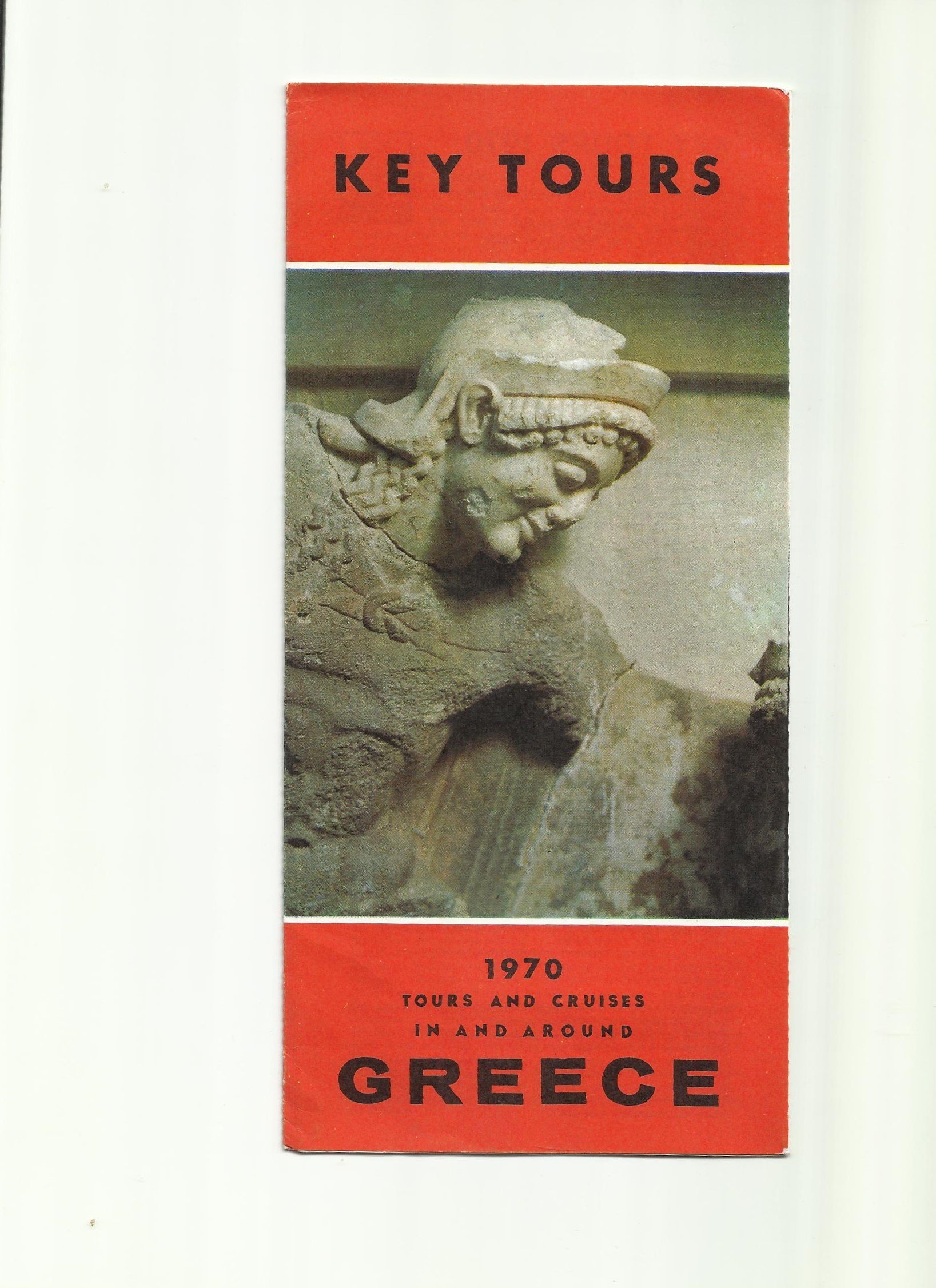
KEY TOURS
1970
TOURS AND CRUISES
IN AND AROUND

1
KEY TOURS 1970
ATHENS SIGHTSEEING
DAILY ALL THE YEAR
A. MORNING HALF-DAY TOUR. Departure: 9.00 a.m. Return 12.00 noon. Drs. 75 or $2.50 Leave at 9 a.m. for the National Museum (visit), the National Library, the University, the Academy, the residential area, the Royal Palace, the Stadium (visit), Temple of Olympian Zeus (visit), the Arch of Hadrian, the Cathedral of Athens and the church of St. Eleftherios (visit). (N.B. On Mondays the Benaki Collection is visited instead of the Nation& Museum).
2 ATHENS BY NIGHT TWO DIFFERENT ASPECTS OF ATHENS. NIGHT LIFE
A. ON THE TOWN Including aperitifs, a waterfront visit, dinner, night-club, and floor show. EVERY NIGHT, ALL THE YEAR Departure: 8.30 p.m. Return approximately 1.00 a.m. Drs. 240 or S 8.00 with dinner. Refreshments at a tavern. Drive to the picturesque port of Turkoli-mano yacht harbor on the Bay of Athens. Afterwards, dinner at one of the popular, typically Greek, night clubs-dancing and floor show. During the month of September this tour visits the Wine Festival, followed by dinner, night-club and floor show.
B. THEATER NIGHT Sound and Light Spectacle and Greek Folk Dances. MAY 1 st to OCTOBER 31st EVERY NIGHT (except on full-moon nights) Departure: 8.30 p.m. Return approximately midnight. Drs. 120 or $4.00 without dinner. This tour has been organized to attend the "Sound and Light Spec-tacle" and a performance of outstanding Greek folk dancing.
3 CAPE SOUNION IN THE AFTERNOON DAILY ALL THE YEAR Departure: 3.30 p.m. Return approximately 9.00 p.m. in Summer. Schedule (April 1st to September 15th). Drs. 180 or S 6.00 with dinner (Summer only). Drs. 120 or S 4.00 without dinner. Leave Athens at 3.30 p.m. (3.00 p.m. September 16th to March 31st) and drive along the coastal highway to Cape Sounion. Visit the temple of Poseidon, swimming possible, (dinner optional Summer only). Return to Athens at approximately 9.00 p.m. (During Winter season return approximately 8.00 p.m.).

4 OLD CORINTH (Morning Tour)
DAPHNI (visit) - ELEUSIS (visit) - CORINTH CANAL (short stop) - OLD CORINTH (visit) MARCH 15th to OCTOBER 31st DAILY. Departure: 8.00 a.m. Return 2.00 p.m. Drs. 150 or $5.00 without lunch.
5 ONE DAY IN THE ARGOLIS REGION
OLD CORINTH - MYCENAE - NAUPLIA - EPIDAURUS
DAILY ALL THE YEAR
Departure: 8.00 a.m. Return approximately 9.00 p.m.
Drs. 390 or S 13.00 including lunch. Drs. 330 or S 11.00 without lunch.
Leave Athens at 8.00 a.m. via the new scenic highway to the Corinth Canal (short stop). Proceed to Old Corinth (visit). Mycenae. (visit) and lunch at Nauplia, where &short swim is possible.•Leave Nauplia after lunch for Epidaurus to visit the sanctuary and theater. Return to Athens at approximately 9.00 p.m.
AIR CONDITIONED BUS
6 ONE DAY TO DELPHI AND ST. LUKE
DAILY ALL THE YEAR
Departure: 8.00 a.m. Return approximately 9.00 p.m.
Drs. 390 or S 13.00 including lunch Drs. 330 or S 11.00 without lunch
A visit to Delphi, and probably the most interesting antiquity in Greece, is combined with a visit to the Byzantine Monastery of St. Luke (unique Byzantine mosaics). Return to Athens at approximately 9.00 p.m.
AIR CONDITIONED BUS
7 TWO DAYS IN THE ARGOLIS REGION
OLD CORINTH - MYCENAE - NAUPLIA - EPIDAURUS
DAILY ALL THE YEAR
Departure: 8.00 a.m. Return approximately 9.00 p.m. second day.
First class : Drs. 720 or $ 24.00 (full board),
Tourist class: Drs. 570 or $ 19.00 (full board).
This tour is designed ,to provide a leisurely visit of the interesting Argolis region with an overnight in Nauplia. NOTE: Only 1st class accommodation is available during the winter season.
AIR CONDITIONED BUS
8 TWO DAYS TO DELPHI AND ST. LUKE
DAILY ALL THE YEAR
Departure: 8.00 a.m. Return approximately 9.00 p.m. second day.
First class : Drs. 720 or $ 24.00 (full board).
Tourist class : Drs. 570 or $19.00 (full board).
This tour is for those who want leisurely enjoyment of the impressive site and museum at Delphi.
NOTE: During the Winter season only first class accommodation is available.
AIR CONDITIONED BUS
9 FOUR DAY CLASSICAL/BYZANTINE TOUR
OLD CORINTH - MYCENAE - EPIDAURUS - NAUPLIA -OLYMPIA - DELPHI - ST. LUKE
MARCH 15th to OCTOBER 31st. DAILY
NOVEMBER 1st to MARCH 14th EVERY WEDNESDAY AND FRIDAY Departure: 8.00 a.m. Return approximately 9.00 p.m. fourth day.
First class : Drs. 2,010 or $67.00 (full board).
Tourist class: Drs. 1,650 or $55.00 (full board).
1st day: Leave Athens at 8.00 a.m. Proceed via the new scenic high-way overlooking the Bay of Salamis and the Saronic Gulf to the Co-rinth Canal for a short stop—then visit Old Corinth—and afterwards to Mycenae and lunch. After lunch, leave for Epidaurus to visit the Theater, site and museum and proceed to Nauplia. Swimming pos-sible. Dinner and overnight at Nauplia.

2nd day: Leave Nauplia at 8.00 a.m. for Vytina (short stop). Drive to Olympia for lunch and visit of the antiquities and Museum. Dinner and overnight at Olympia.
3rd day: Leave Olympia at 8.00 a.m. and drive via Patras to Rion, cross the Corinthian Gulf by ferry boat, and drive up to Delphi. Lunch, dinner and overnight at Delphi.
4th day: Complete visit of the site and museum at Delphi. Depart after lunch for the Byzantine Monastery of St. Luke. Return to Athens approximately 9.00 p.m.
10 FIVE DAY ARCHAEOLOGICAL TOUR
OLD CORINTH - MYCENAE - EPIDAURUS - NAUPLIA - SPARTA - MYSTRA - OLYMPIA - DELPHI - ST. LUKE
MARCH 14th to OCTOBER 29th EVERY THURSDAY & SATURDAY
Departure: 8.00 a.m. Return 9.00 p.m. approx. (5th day).
First class : Drs. 2,370 or 579.00 (full board).
Tourist class: Drs.-1,920 or $64.00 (full board).
1st day: Leave Athens at 8.00 a.m. Drive via the new scenic high-way to the Corinth Canal (short. stop), proceed to Old Corinth for visit of the site. Drive to Mycenae for visit and lunch. Leave after lunch for the visit to Epidaurus. Arrive in Nauplia in the afternoon. Swimming possible. Dinner and overnight at Nauplia.
2nd day: Leave Nauplia at 8.00 a.m. for Tripolis for a short stop. Drive to Sparta for lunch. In the afternoon visit the Byzantine Monas-teries at Mystra. Dinner and overnight at Sparta.
3rd day: Leave Sparta for Olympia.at 8.00 a.m. arriving at Olympia for lunch. After lunch visit the site and museum at Olympia. Dinner and overnight at Olympia.
4th day: Leave at 8.00 am. for Patras. Cross the Corinthian Gulf by ferry boat. Drive up to Delphi. Dinner and overnight at Delphi.
5th day: Complete visit of the Delphi sanctuary and museum. Leave after lunch for the Byzantine Monastery of St. Luke. Return to Athens at approximately 9.00 p.m.
ALTERNATIVES:
10A SIX DAY CLASSICAL TOUR WITH METEORA
The five-day tour leaving Athens on Saturdays can be extended by one day to include Meteora with its famous Monasteries. Supplement: Drs. 540 or 818.00 (full board). The five-day tour leaving Athens on Thursdays can be extended by four days, to include the Meteora and Northern Greece. See tour No. 24.
11 FIVE DAYS TO THE CLASSICAL SITES OF GREECE AND METEORA
OLD CORINTH - MYCENAE - EPIDAURUS - NAUPLIA -OLYMPIA - DELPHI - METEORA - THERMOPYLAE
MARCH 15th to OCTOBER 28th EVERY WEDNESDAY & SUNDAY
Departure: 8.00 a.m. Return approximately 9.00 p.m. fifth day.
First class : Drs. 2,550 or $85.00. Tourist class: Drs. 2,190 or $73.00.
1st day: Leave Athens at 8.00 a.m. Proceed via the new scenic high-way to the Corinth Canal (short stop). Visit the site of Old Corinth, and proceed to Mycenae to visit the site and lunch. Depart after lunch for a visit to Epidaurus theater and museum. Drive to Nauplia in the afternoon. Swimming possible. Dinner and overnight at Nauplia.
2nd day : Leave Nauplia at 8.00 a.m. and drive to Tripolis (short stop) and 'proceed to Olympia for lunch. After lunch visit the museum and Antiquities. Dinner and overnight at Olympia.
3rd day: Depart at 8.00 am. and drive through Patras to Rion. Cross the Corinthian Gulf by ferry boat and drive up to Delphi for lunch. Partial visit of the site at Delphi. Dinner and overnight at Delphi.
4th day: Complete the visit of the site and the museum at Delphi. Depart after lunch for Lamia and Kalambaka. Dinner and overnight at Kalambaka.
5th day: Leave at 8.00 am. for a visit of the Byzantine Monasteries of Meteora. Return to Kalambaka for lunch and depart afterwards for a visit to the Pass of Thermopylae (here the Greeks defeated the Persians in 480 B.C.;. Atkers ‘,,inq approximately 9.00p.m.

12 THREE DAY CLASSICAL TOUR TO DELPHI AND METEORA
DELPHI - METEORA - THERMOPYLAE
MARCH 17th to OCTOBER 30th EVERY TUESDAY & FRIDAY
Departure: 8.00 a.m. Return 9.30 p.m. third day. First class only: Drs. 1,410 or $ 47.00 (full board).
1st day; Leave Athens at 8.00 a.m. via the new national highway for Delphi passing through Thebes and Levadia. Lunch at Delphi visit of the site and museum. Overnight at Delphi.
2nd day: Morning free in Delphi. After lunch depart for Kalambaka (Meteora) via Lamia. Dinner and overnight at Kalambaka.
3rd day : Leave at 8.00 a.m. for nearby Meteora to visit the Byzantine Monasteries. Return to Kalambaka for lunch. Depart after lunch for a visit to the Pass of Thermopylae. Return to Athens arriving approxi-mately 9.00 p.m.
13 TWO DAY TOUR DELPHI-OLYMPIA
MARCH 17th to OCTOBER 30th EVERY TUESDAY & FRIDAY
Departure: 8.00 a.m. Return: 9.30 p.m. second day.
First class only : Drs. 900 or $ 30.00 (full board).
THEBES - LEVADIA - DELPHI (lunch-visit) - NAFPAKTOS (crossing by car ferry) - RION - PATRAS (dinner-overnight stay) - OLYMPIA (visit-lunch) - PATRAS - AEGION - XYLOKASTRON - CORINTH - ATHENS
14 HALF DAY TOUR OF ATTICA
(including Marathon)
APRIL 1st to.00TOBER 31st EVERY WEDNESDAY & SATURDAY
Departure: 8.00 a.m. Return: 1.30 p.m.
Drs. 120 or $4.00 (including refreshments).
PSYCHICO - FILOTHEI - KIFISSIA - EKALI - DIONYSSOS - NEA MAKRI - MARATHON (Tomb) - KOROPI - VARKIZA - VOULIAGMENI - ATHENS
15 SIX DAY TOUR' TO NORTHERN GREECE
APRIL 5th to OCTOBER 27th EVERY SUNDAY
Departure: 8.00 a.m. Return: 9.00 p.m. sixth day.
First class only : Drs. 3,210 or $ 107.00 (full board).
THEBES - LEVADIA - OSSIOS LUKAS (visit) - ARAKHOVA -DELPHI (lunch-visit-dinner-overnight stay) - LEVADIA - KAMMENA VOURLA - LAMIA - DOMOKOS - KARDITSA -KALAMBAKA (lunch) - METEORA (visit) - KALAMBAKA (dinner-overnight stay) - TRIKALA - KATERINI - SALONICA (lunch-dinner-overnight stay) - SALONICA (visit-lunch) - AMPHIPOLIS - KAVALA (visit-dinner-overnight stay) - THASSOS•(visit-lunch) - KAVALA - PHILIPPI (visit) -SALONICA (dinner-overnight stay) - PELLA (visit) -KATERINI (lunch) - LARISSA - LAMIA - ATHENS
16 ONE DAY CRUISE
THE ISLANDS OF THE BAY OF ATHENS (SARONIC GULF) - AEGINA - POROS - HYDRA
DAILY, MARCH 15th to OCTOBER 31st
Departure: 8.00 a.m. Return approximately 8.00 p.m.
Drs. 420 or $14.00 including lunch on board.
The Saronic islands of the Bay of Athens have taken their place in the history of Greece, playing a most important role during the 1821 Greek War of Independence. The imposing temples and the pictures-que villages, with their old-world flavor, are all part of a typical Greek island visit.
Leave Athens at 7.30 am. by bus to Piraeus. Sail for the island of Aegina and visit the temple of Aphaia. Swimming possible. Box lunch on board. Cruise through the Straits of Poros to Hydra (visit). Sail back to Piraeus and transfer by bus to Athens arriving approximately 8.00 p.m.

17
WEEKEND CRUISES TO THE AEGEAN ISLANDS ON SS ROMANTICA" AND M/V "SEMIRAMIS" Visiting HYDRA - DELOS - MYKONOS
JUNE 27th to OCTOBER 24th EVERY SATURDAY
Departure: Noon. Return approximately 8.00 a.m. on Monday.
From Drs. 750 or $ 25.00 (full board).
To Drs. 3,000 or $100.00 (full board).
Shore excursions and transfers to and from Piraeus are included in the price.
1st day: Leave Athens at noon for Piraeus to board either the SS "ROMANTICA" or the M/V "SEMIRAMIS". Depart from Piraeus harbor at 2.00 p.m. Sail for the island of Hydra arriving at 5.00 p.m. Shore visit. Depart for Delos at 10.00 p.m. (M/V "SEMIRAMIS") or midnight (SS "ROMANTICA").
2nd day: Arrive at the island of Delos. Shore visit. Proceed to island-resort of Mykonos which is one hour's sailing time away. Shore visit. Both depart approximately 10.00 p.m. for Piraeus.
3rd day: Arrive at Piraeus at approximately 7.30 a.m. Bus transfer to Athens arriving approximately 8.30 a.m.
ALTERNATIVES: A. ON SS "CARINA"
HYDRA - HERAKLEION - SANTORINI
MARCH 28th to JUNE 13th EVERY SATURDAY
Departure : 2.00 p.m. Return approximately 8.00 a.m. on Monday.
From Drs. 690 or $ 23.00 (full board).
To Drs. 1,800 or $ 60.00 (full board).
B. ON SS "APOLLO" HALICARNASSUS (on Turkish coast) - COS - RHODES -SANTORINI - MYKONOS - DELOS
MARCH 27th to OCTOBER 23rd EVERY FRIDAY
Departure: 7.00 p.m. Return approximately 6.00 a.m. on Monday.
From Drs. 1,650 or $ 55.00 (full board).
To Drs. 6,000 or $ 200.00 (full board).
18 THREE DAY CRUISE TO THE AEGEAN ISLANDS ON M/S •'STELLA SOLARIS"
Visiting DELOS - MYKONOS - RHODES - HERAKLEION -SANTORINI
APRIL 3rd to OCTOBER 23rd EVERY FRIDAY
Departure: 9.00 a.m. Return approximately 8.00 a.m. Monday. From Drs. 2,400 or $ 80.00
To Drs. 7,050 or $ 235.00
Transfers to and from Piraeus, and shore excursions are included in the price, except the excursion to Lindos.
(Supplement of Drs. 150 or $5.00).
1st day: Bus transfer to Piraeus leaves at 10.00 a.m. Sail from Pi-raeus at 11.00 a.m. arriving at Delos at 5.00 p.m. Visit the island, and depart at 7.30 p.m. for the island of Mykonos. Arrival at Mykonos 8.00 p.m., optional visit ashore. Ship departs Mykonos at 11.30 p.m.
2nd day: Arrive Rhodes at 1.00 p.m. Optional to spend entire day ashore or on the ship. Optional excursion to Lindos. Depart Rhodes at 8.30 p.m.
3rd day : Arrive at Herakleion, Crete at 7.30 a.m. Visit to the palace of Knossos. Ship departs at 12.30 p.m. for the island of Santorini. Arrival at Santorini at 4.30 p.m. Optional visit ashore. Depart Santorini for Piraeus at 8.30 p.m.
4th day: Arrive in Piraeus harbor at 7.00 am. Transfer to Athens arriving Hotel Grande Bretagne approximately 8.00 a.m.
19 FOUR DAY CRUISE TO THE AEGEAN ISLANDS ON M/S "STELLA SOLARIS"
Visiting HYDRA - SANTORINI - HERAKLEION - RHODES - KUSADASI - EPHESSOS - MYKONOS
MARCH 30th to OCTOBER 19th EVERY MONDAY
Departure: 4.00 p.m. Return approximately 8.00 a.m. (Friday).
From Drs. 2,850 or $ 95.00
To Drs. 8,400 or $ 280.00
Transfers to and from Piraeus and shore excursions are included
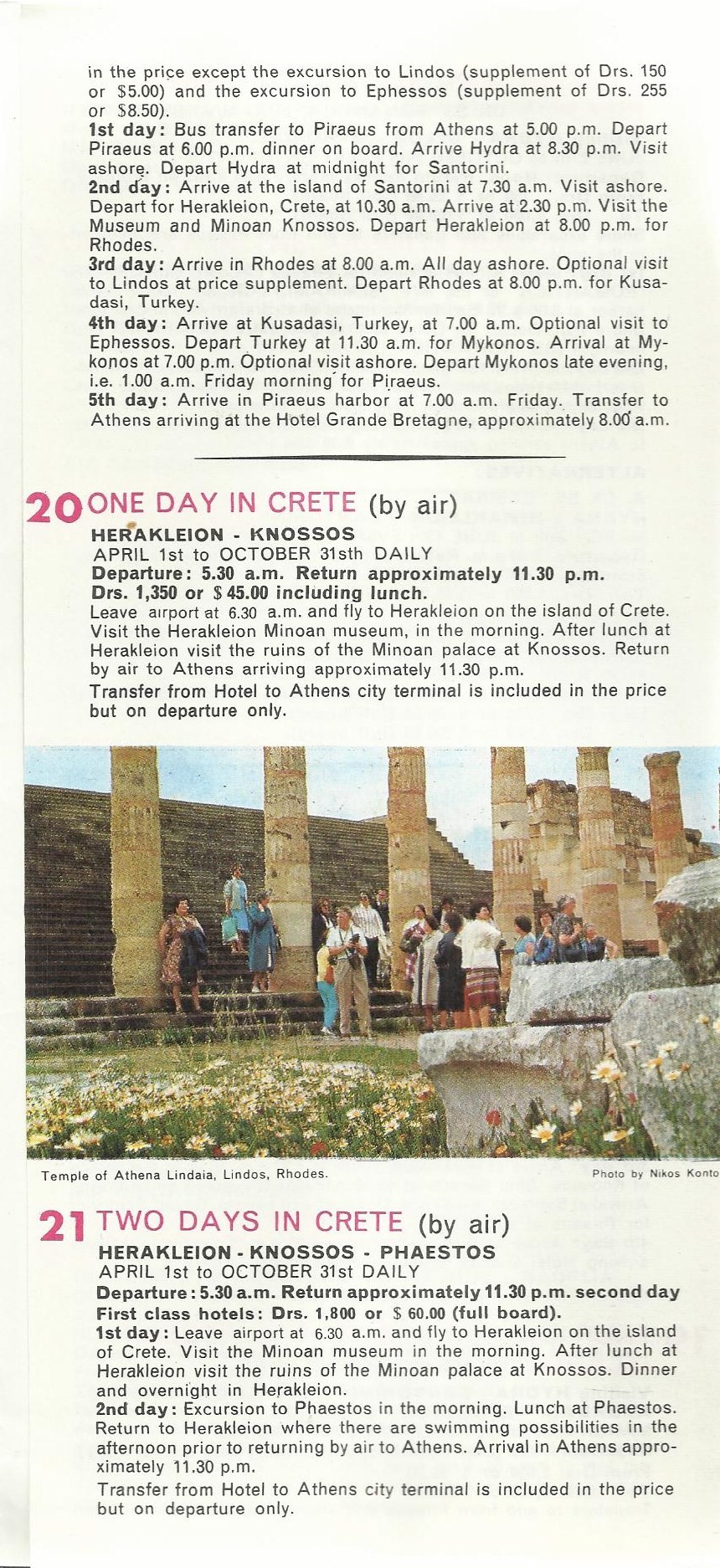
in the price except the excursion to Lindos (supplement of Drs. 150 or $5.00) and the excursion to Ephessos (supplement of Drs. 255 or 38.50).
1st day: Bus transfer to Piraeus from Athens at 5.00 p.m. Depart Piraeus at 6.00 p.m. dinner on board. Arrive Hydra at 8.30 p.m. Visit ashore. Depart Hydra at midnight for Santorini.
2nd day: Arrive at the island of Santorini at 7,30 a.m. Visit ashore. Depart for Herakleion, Crete, at 10.30 a.m. Arrive at 2.30 p.m. Visit the Museum and Minoan Knossos. Depart Herakleion at 8.00 p.m. for Rhodes.
3rd day: Arrive in Rhodes at 8.00 a.m. All day ashore. Optional visit to Lindos at price supplement. Depart Rhodes at 8.00 p.m. for Kusa-dasi, Turkey.
4th day: Arrive at Kusadasi, Turkey, at 7.00 a.m. Optional visit to Ephessos. Depart Turkey at 11.30 a.m. for Mykonos. Arrival at My-konos at 7.00 p.m. Optional visit ashore. Depart Mykonos late evening, i.e. 1.00 a.m. Friday morning for Piraeus.
5th day: Arrive in Piraeus harbor at 7.00 a.m. Friday. Transfer to Athens arriving at the Hotel Grande Bretagne, approximately 8.06 a.m.
20 ONE DAY IN CRETE (by air)
HERAKLEION - KNOSSOS
APRIL 1st to OCTOBER 31sth DAILY
Departure: 5.30 a.m. Return approximately 11.30 p.m.
Drs. 1,350 or $45.00 including lunch.
Leave airport at 6.30 a.m. and fly to Herakleion on the island of Crete. Visit the Herakleion Minoan museum, in the morning. After lunch at Herakleion visit the ruins of the Minoan palace at Knossos. Return by air to Athens arriving approximately 11.30 p.m. Transfer from Hotel to Athens city terminal is included in the price but on departure only.
21 TWO DAYS IN CRETE (by air)
HERAKLEION - KNOSSOS - PHAESTOS
APRIL 1st to OCTOBER 31st DAILY
Departure : 5.30 a.m. Return approximately 11.30 p.m. second day
First class hotels: Drs. 1,800 or $ 60.00 (full board).
1st day : Leave airport at 6.30 a.m. and fly to Herakleion on the island of Crete. Visit the Minoan museum in the morning. After lunch at Herakleion visit the ruins of the Minoan palace at Knossos. Dinner and overnight in Herakleion.
2nd day: Excursion to Phaestos in the morning. Lunch at Phaestos. Return to Herakleion where there are swimming possibilities in the afternoon prior to returning by air to Athens. Arrival in Athens appro-ximately 11.30 p.m. Transfer from Hotel to Athens city terminal is included in the price but on departure only.

22 TWO DAYS IN RHODES (by air)
RHODES - LINDOS
APRIL 1st to OCTOBER 31st DAILY
Departure: 6.30 a.m. Return approximately 11.00 p.m. 2nd day.
First class hotels:. Drs. 2,100 or $ 70.00 (full board).
1st day: Leave airport at 8.00 a.m. by air for the island of Rhodes. Morning free—swimming possible. After lunch, at Rhodes, an after-noon excursion to Lindos. Dinner and overnight at Rhodes:
2nd day : Visit the old town of Rhodes in the morning. Lunch at Rho-des. Afternoon free—swimming possible. Return to Athens by air arriving approximately 11.00 p.m. Transfer from Hotel to Athens city terminal is included in the price but on departure only.
23 THREE DAYS TO CRETE AND RHODES (by air)
HERAKLEION - KNOSSOS - RHODES - LINDOS
APRIL 1st to OCTOBER 31st EVERY MONDAY, WEDNESDAY & FRIDAY Departure: 9.15. a.m. Return approximately 11.30 p.m. (3rd day).
First class hotels : Drs. 3,000 or $ 100.00 (full board).
1st day : Depart from Olympic Airways city terminal at 9.55 a.m. for the Athens airport, and then fly to Herakleion arriving at approxima-tely 1.00 p.m. Lunch at Herakleion. After lunch visit Knossos. Dinner and overnight at Herakleion.
2nd day:. Visit to Museum in the morning. Lunch at Herakleion. After lunch two hours free. At 5.30 p.m. depart from Herakleion city terminal for airport and fly to Rhodes arriving at approximately 9.00 p.m. Dinner and overnight at Rhodes.
3rd day : Morning sightseeing of the old city of Rhodes. After lunch excursion to Lindos. At 6.45 p.m. depart from Rhodes city terminal for airport and fly to Athens arriving at the Athens city terminal at approximately 10.40 p.m. Transfer from Hotel to Athens city terminal is included in the price but on departure only.
24 NINE DAY GRAND TOUR OF GREECE
APRIL 9th to SEPTEMBER 24th EVERY THURSDAY
Departure: 8.00 a.m. Return: 9.00 p.m. (9th day).
First class only: Drs. 4,650 or $155.00 (full board). CORINTH (visit) - MYCENAE (visit-lunch) - EPIDAURUS (visit) - NAUPLIA (dinner-overnight stay) - TRIPOLIS - SPARTA (lunch) - MYSTRA (visit) - SPARTA (dinner-overnight stay) - VYTINA (refreshments) - OLYMPIA (lunch-visit-dinner-overnight stay) - PATRAS - RION (crossing by car ferry) - NAFPAKTOS - DELPHI (lunch-visit-dinner-overnight stay) - LEVADIA - KAMMENA VOURLA - LAMIA - DOMOKOS - KARDITSA - TRIKALA - KALAMBAKA (lunch) - METEORA (visit) - KALAMBAKA (dinner-overnight stay) - TRIKALA - KATERINI - SALONICA (lunch-dinner-overnight stay) - SALONICA (visit-lunch) - AMPHIPOLIS - KAVALA (visit-dinner-overnight stay) - THASSOS (visit-lunch) - KAVALA - PHILIP-PI (visit) - SALONICA (dinner-overnight stay) - PELLA (visit) - KATERINI (lunch) - LARISSA - LAMIA - ATHENS. This tour can be taken on a sectional basis, anywhere en route. Ask for detailed programme and rates.
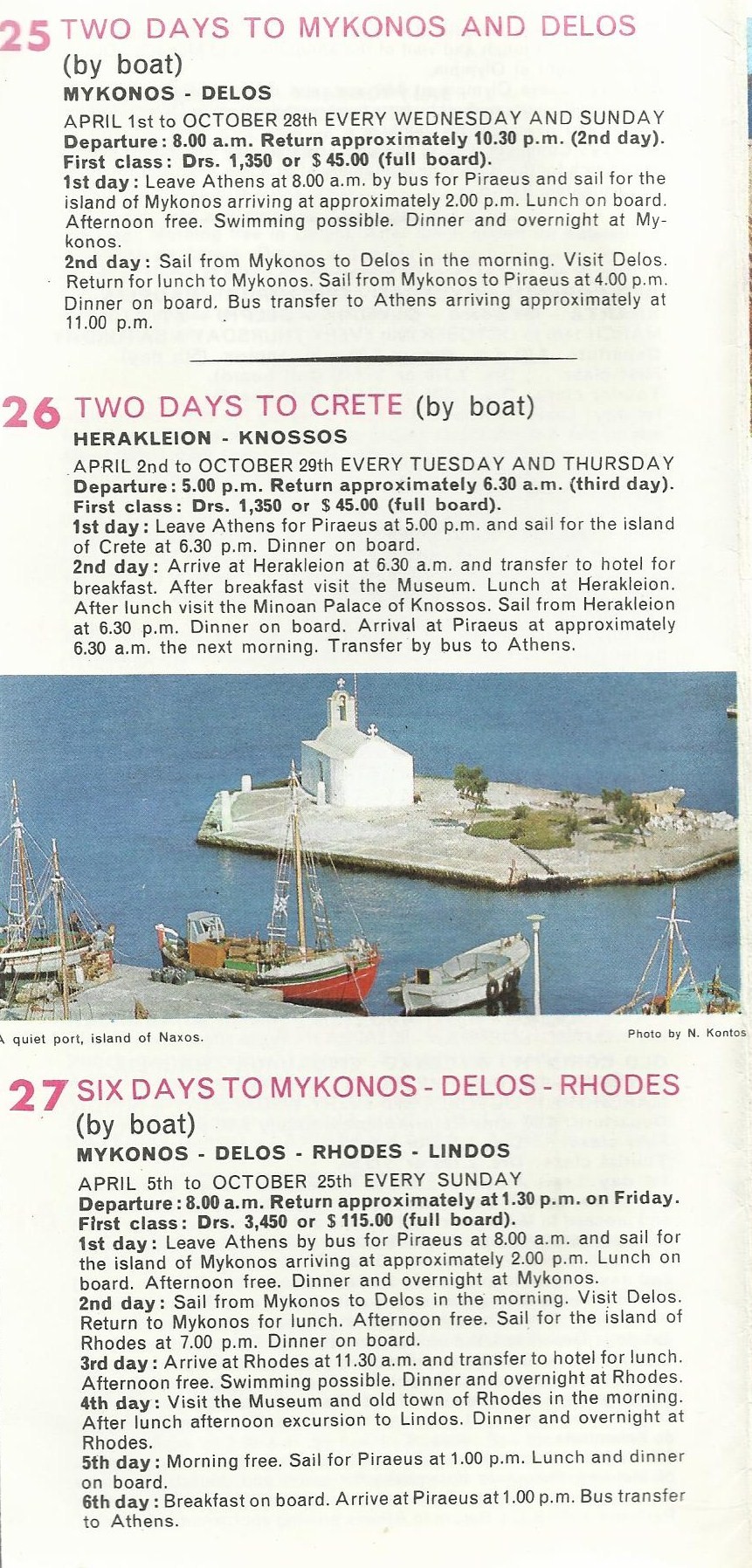
25 TWO DAYS TO MYKONOS AND DELOS (by boat) MYKONOS - DELOS APRIL 1st to OCTOBER 28th EVERY WEDNESDAY AND SUNDAY
Departure: 8.00 a.m. Return approximately 10.30 p.m. (2nd day).
First class: Drs. 1,350 or $ 45.00 (full board).
1st day : Leave Athens at 8.00 a.m. by bus for Piraeus and sail for the island of Mykonos arriving at approximately 2.00 p.m. Lunch on board. Afternoon free. Swimming possible. Dinner and overnight at My-konos.
2nd day : Sail from Mykonos to Delos in the morning. Visit Delos. Return for lunch to Mykonos. Sail from Mykonos to Piraeus at 4.00 p.m. Dinner on board. Bus transfer to Athens arriving approximately at 11.00 p.m.
26 TWO DAYS TO CRETE (by boat)
HERAKLEION - KNOSSOS
APRIL 2nd to OCTOBER 29th EVERY TUESDAY AND THURSDAY
Departure: 5.00 p.m. Return approximately 6.30 a.m. (third day).
First class: Drs. 1,350 or $ 45.00 (full board).
1st day: Leave Athens for Piraeus at 5.00 p.m. and sail for the island of Crete at 6.30 p.m. Dinner on board.
2nd day : Arrive at Herakleion at 6.30 a.m. and transfer to hotel for breakfast. After breakfast visit the Museum. Lunch at Herakleion. After lunch visit the Minoan Palace of Knossos. Sail from Herakleion at 6.30 p.m. Dinner on board. Arrival at Piraeus at approximately 6.30 a.m. the next morning. Transfer by bus to Athens.
27 SIX DAYS TO MYKONOS - DELOS - RHODES (by boat)
MYKONOS - DELOS - RHODES - LINDOS
APRIL 5th to OCTOBER 25th EVERY SUNDAY
Departure: 8.00 a.m. Return approximately at 1.30 p.m. on Friday.
First class : Drs. 3,450 or $ 115.00 (full board).
1st day : Leave Athens by bus for Piraeus at 8.00 a.m. and sail for the island of Mykonos arriving at approximately 2.00 p.m. Lunch on board. Afternoon free. Dinner and overnight at Mykonos.
2nd day : Sail from Mykonos to Delos in the morning. Visit Delos. Return to Mykonos for lunch. Afternoon free. Sail for the island of Rhodes at 7.00 p.m. Dinner on board.
3rd day : Arrive at Rhodes at 11.30 a.m. and transfer to hotel for lunch. Afternoon free. Swimming possible. Dinner and overnight at Rhodes.
4th day: Visit the Museum and old town of Rhodes in the morning. After lunch afternoon excursion to Lindos. Dinner and overnight at Rhodes.
5th day : Morning free. Sail for Piraeus at 1.00 p.m. Lunch and dinner on board. 6th day : Breakfast on board. Arrive at Piraeus at 1.00 p.m. Bus transfer to Athens.
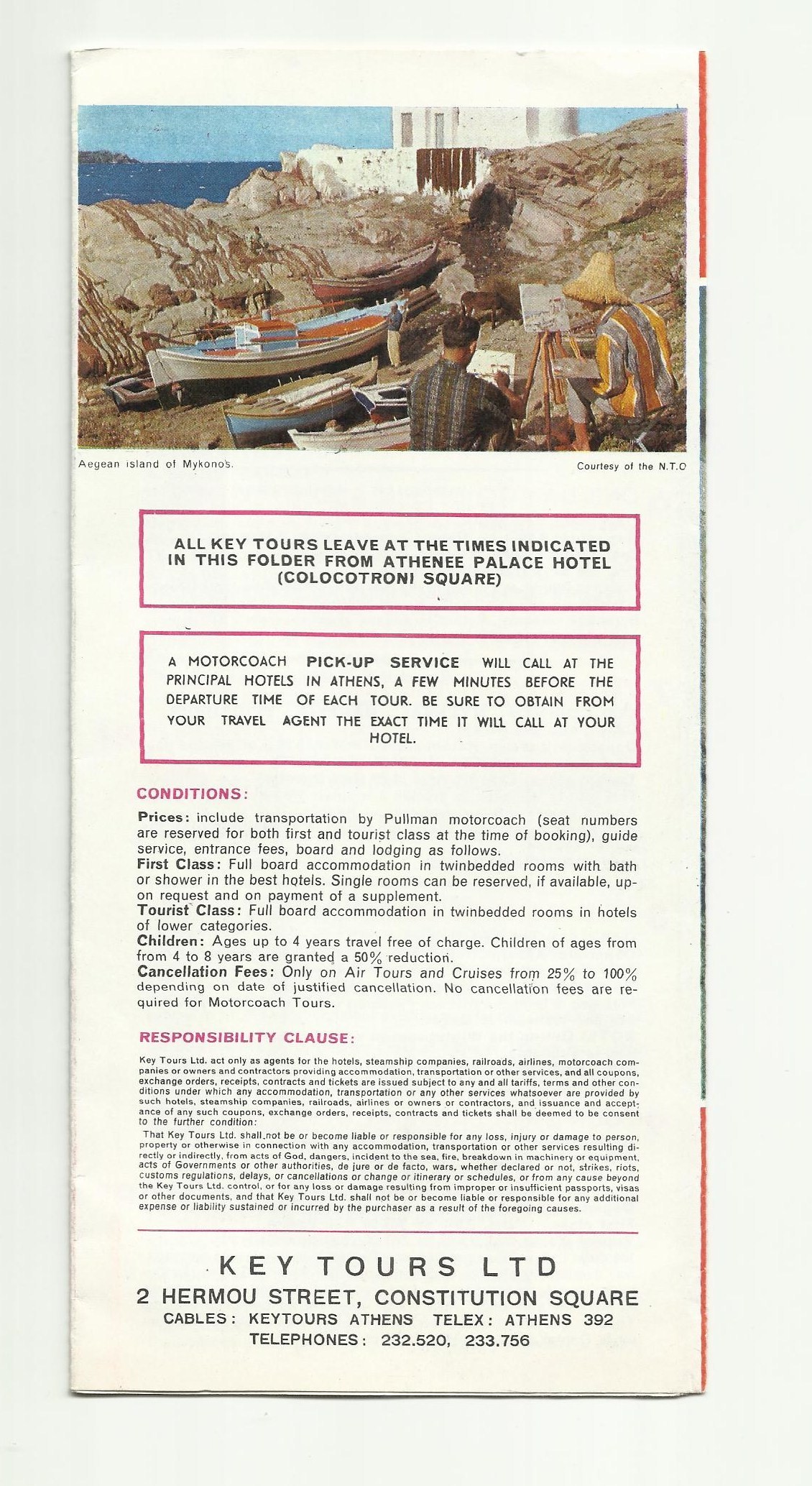
.................................................................................................................
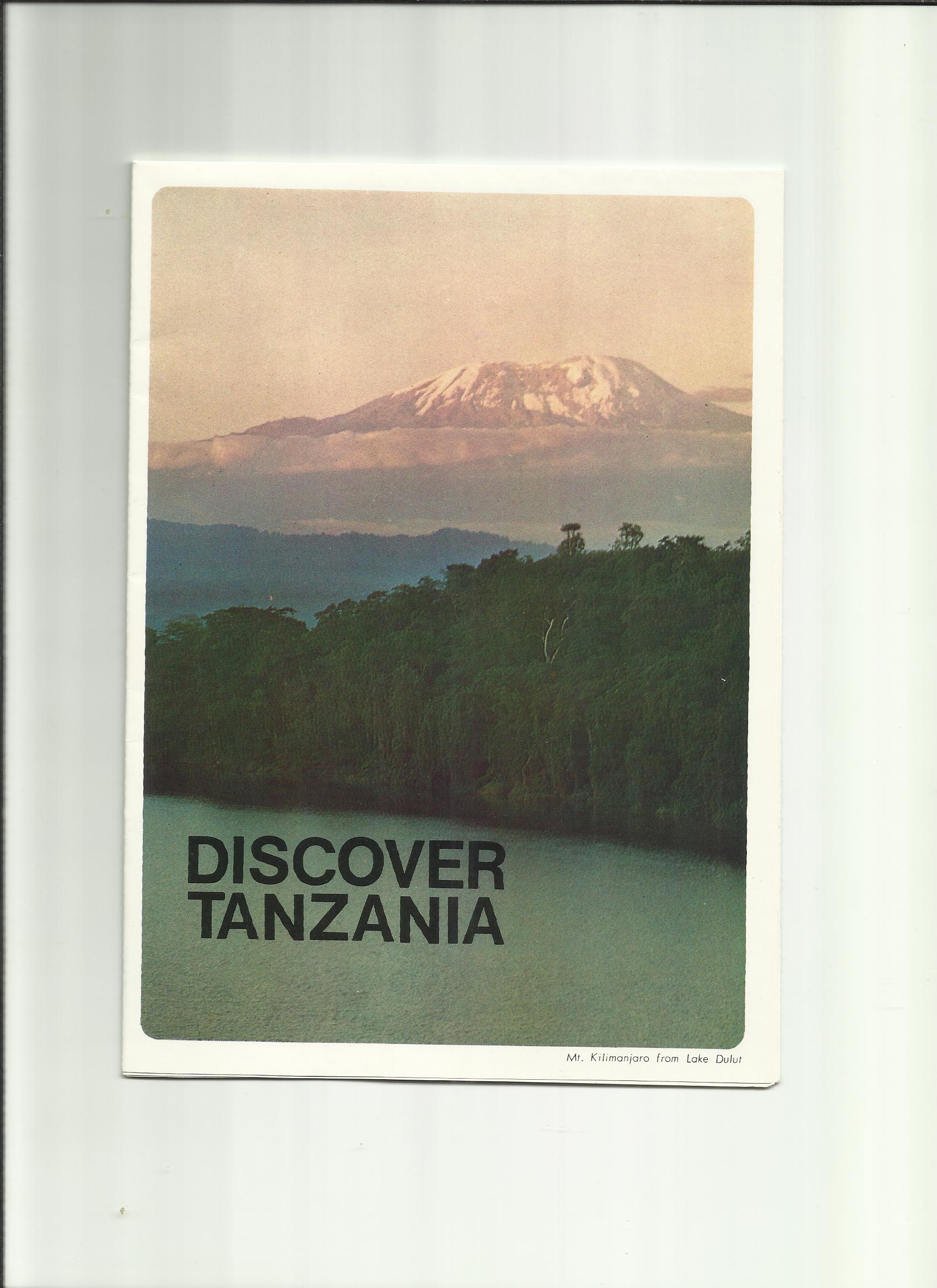
DISCOVER
TANZANIA


TANZANIA
is, in many ways, representative of Africa today. Newly-independent, dynamic and thrusting, with the 20th-century symbols of parliament buildings, modern transport, blocks of new homes, schools, factories and industrial complexes. Side by side with these characteristics are the age-old glories of Africa's cultural heritage, the phenomenon of its myriad wildlife and scenic grandeur that defies description. There are also the people, deriving from some 120 tribes, now busily engaged in nation building; the citizens of a new state to meet and talk with. Their music and dancing to share if one wishes. All this exists as a total experience for the traveller to Tanzania—the Africa of today and the Africa that is eternal. Lying just south of the equator in Eastern Africa, Tanzania comprises the mainland of 362,000 square miles (including 20,000 of inland water) and the islands of Zanzibar (640 square miles) and Pemba 380 square miles). The mainland population is in the region of 12 million, while the population of the two islands is 350,000. On December 9th, 1961, Tanganyika attained in-dependence, and exactly a year later the country became a Republic within the Commonwaelth. Zanzibar became independent on December 11th, 1963, but only a month later a popular movement deposed the Sultan and brought into being a Republic. On April 26th, 1964, the two sovereign states joined to form the United Republic of Tanganyika and Zanzibar, which became the United Republic of Tanzania on October 29th, 1964. Tanzania is a democratic one-party state, created to provide a framework for uniting the energies and allegiances of people of many tribes, while allowing citizens to freely choose by whom they shall be governed. Executive head of state is President Julius K. Nyerere, a former school teacher who is known to everyone as "Mwalimu," the Swahili word meaning "Teacher". Sheikh Abeid Karume of Zanzibar is the First Vice-President, and Mr. Rashidi Kawawa, Second Vice-President.

The animals "at home"
When you holiday in the National Parks of Tanzania, apart from the pleasure you gain from viewing—and photographing—the world's finest concentration of wildlife, you will also be making a personal contribu-tion to their protection and conservation. Your Park entrance fees• help to meet the cost of maintaining these animal sanctuaries, and combating the menace of poachers. Tanzania has seven National Parks, extending over some 12,000 square miles, in which the wildlife is fully protected and where no human habitation is permitted. In addition, there is the unique Ngorongoro Conser-vation Unit, more than 3,000 square miles of country-side in which the wildlife is protected but where Masai tribesmen also live and herd their cattle. Here is the location of the Ngorongoro Crater. Tanzania, with its enlightened policy of wildlife conservations, also has some ten Game Reserves covering more than 35,000 square miles, which are closed to the general public apart from Government-approved hunting safaris operated under licence, and about 40 Controlled Areas where the hunting of game is controlled by a quota system. The National Parks are : Serengeti (5,000 square miles) Lake Manyara (123 square miles) Arusha (including the Ngurdoto and Mount Meru Craters and Momela Lakes, totalling 45 square miles) Ruaha (5,000 square miles) Mikumi (500 square miles) Tarangire (1,000 square miles) to be opened soon. Gombe (60 square miles)—to be opened soon. The Game Reserves are : The Selous (16,000 square miles) Rungwa (3,500 square miles) Mkomazi (1,400 square miles) Biharamulo (450 square miles) Kilimanjaro (750 square miles) Katavi (650 square miles) Ilgalla (1,800 square miles)
Rubonda Island (85 square miles) Rumanyika Orugundu (80 sguare miles) Maswa (750 square miles)
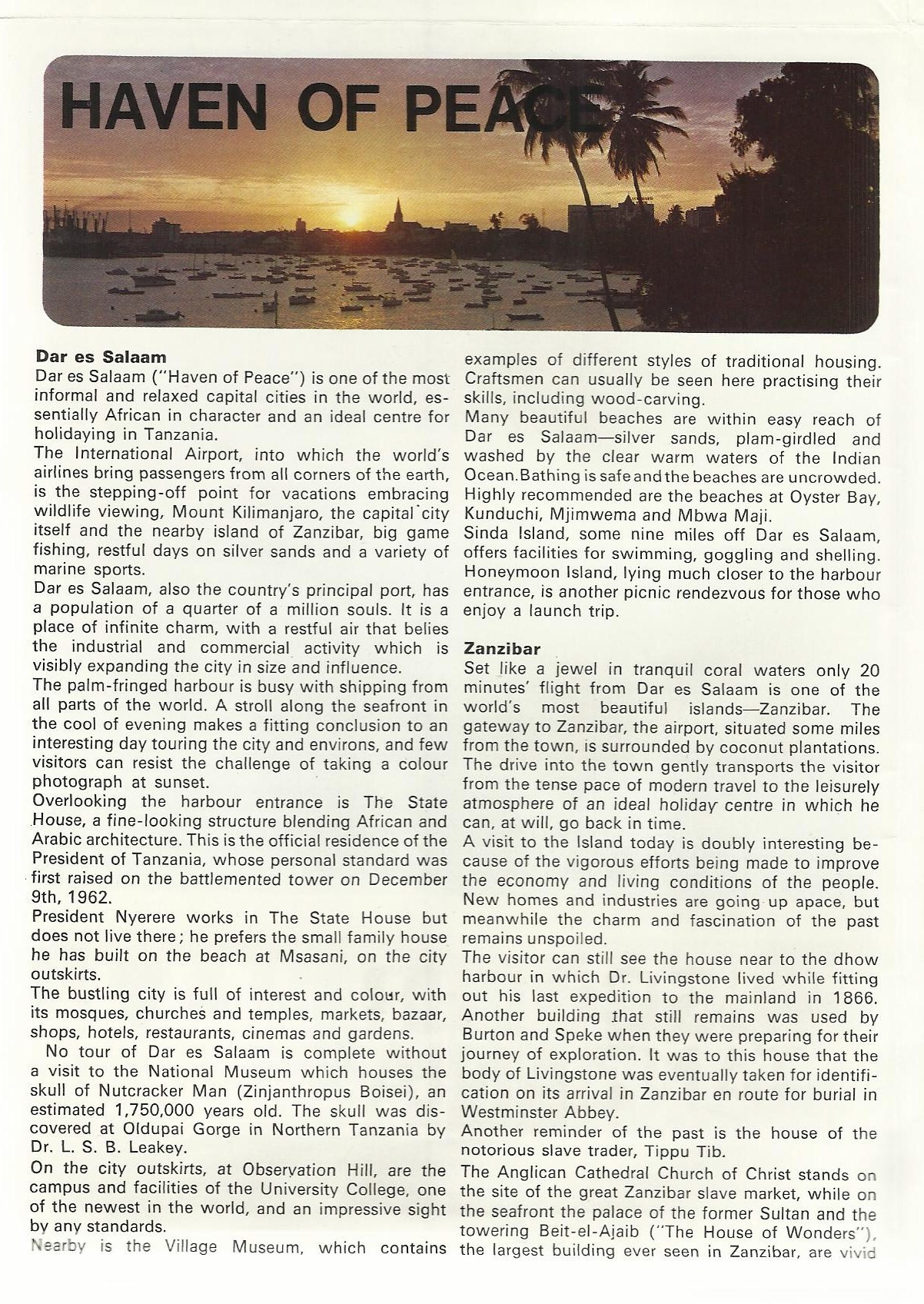
HAVEN OF PEACE
Dar es Salaam
Dar es Salaam ("Haven of Peace") is one of the most informal and relaxed capital cities in the world, es-sentially African in character and an ideal centre for holidaying in Tanzania. The International Airport, into which the world's airlines bring passengers from all corners of the earth, is the stepping-off point for vacations embracing wildlife viewing, Mount Kilimanjaro, the capital city itself and the nearby island of Zanzibar, big game fishing, restful days on silver sands and a variety of marine sports. Dar es Salaam, also the country's principal port, has a population of a quarter of a million souls. It is a place of infinite charm, with a restful air that belies the industrial and commercial activity which is visibly expanding the city in size and influence. The palm-fringed harbour is busy with shipping from all parts of the world. A stroll along the seafront in the cool of evening makes a fitting conclusion to an interesting day touring the city and environs, and few visitors can resist the challenge of taking a colour photograph at sunset. Overlooking the harbour entrance is The State .House, a fine-looking structure blending African and Arabic architecture. This is the official residence of the President of Tanzania, whose personal standard was first raised on the battlemented tower on December 9th, 1962. President Nyerere works in The State House but does not live there; he prefers the small family house he has built on the beach at Msasani, on the city outskirts. The bustling city is full of interest and colour, with its mosques, churches and temples, markets, bazaar, shops, hotels, restaurants, cinemas and gardens. No tour of Dar es Salaam is complete without a visit to the National Museum which houses the skull of Nutcracker Man (Zinjanthropus Boisei), an estimated 1,750,000 years old. The skull was dis-covered at Oldupai Gorge in Northern Tanzania by Dr. L. S. B. Leakey. On the city outskirts, at Obseryation Hill, are the campus and facilities of the University College, one of the newest in the world, and an impressive sight by any standards. Nearby is the Village Museum, which contains examples of different styles of traditional housing. Craftsmen can usually be seen here practising their skills, including wood-carving. Many beautiful beaches are within easy reach of Dar es Salaam—silver sands, plam-girdled and washed by the clear warm waters of the Indian Ocean.Bathing is safe and the beaches are uncrowded. Highly recommended are the beaches at Oyster Bay, Kunduchi, Mjimwema and Mbwa Maji. Sinda Island, some nine miles off Dar es Salaam, offers facilities for swimming, goggling and shelling. Honeymoon Island, lying much closer to the harbour entrance, is another picnic rendezvous for those who enjoy a launch trip.
Zanzibar
Set like a jewel in tranquil coral waters only 20 minutes' flight from Dar es Salaam is one of the world's most beautiful islands—Zanzibar. The gateway to Zanzibar, the airport, situated some miles from the town, is surrounded by coconut plantations. The drive into the town gently transports the visitor from the tense pace of modern travel to the leisurely atmosphere of an ideal holiday centre in which he can, at will, go back in time. A visit to the Island today is doubly interesting be-cause of the vigorous efforts being made to improve the economy and living conditions of the people. New homes and industries are going up apace, but meanwhile the charm and fascination of the past remains unspoiled. The visitor can still see the house near to the dhow harbour in which Dr. Livingstone lived while fitting out his last expedition to the mainland in 1866. Another building that still remains was used by Burton and Speke when they were preparing for their journey of exploration. It was to this house that the body of Livingstone was eventually taken for identifi-cation on its arrival in Zanzibar en route for burial in Westminster Abbey. Another reminder of the past is the house of the notorious slave trader, Tippu Tib. The Anglican Cathedral Church of Christ stands on the site of the great Zanzibar slave market, while on the seafront the palace of the former Sultan and the towering Beit-el-Ajaib ("The House of Wonders"), the largest building ever seen in Zanzibar, are vivid
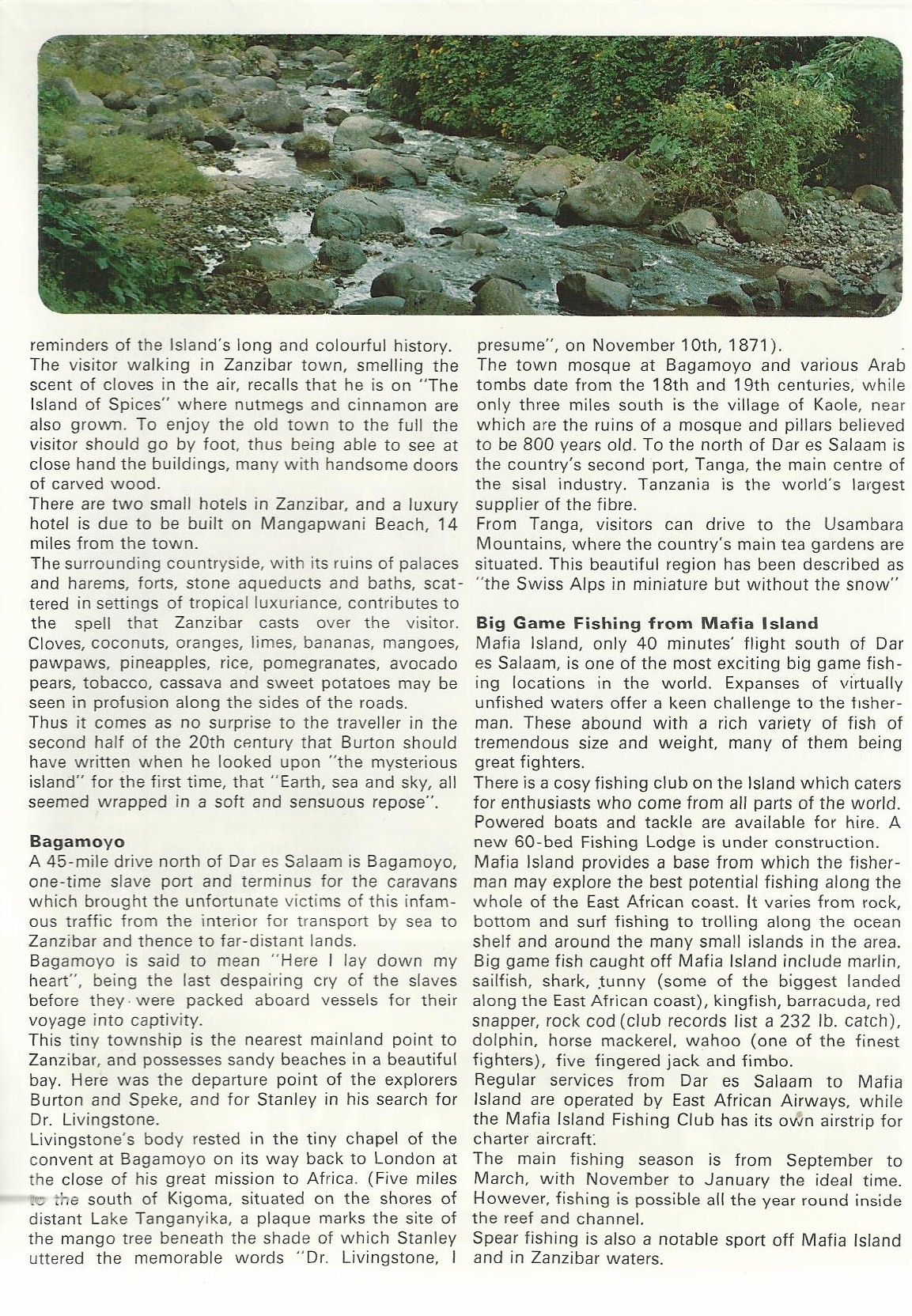
reminders of the Island's long and colourful history. The visitor walking in Zanzibar town, smelling the scent of cloves in the air, recalls that he is on "The Island of Spices" where nutmegs and cinnamon are also grown. To enjoy the old town to the full the visitor should go by foot, thus being able to see at close hand the buildings, many with handsome doors of carved wood. There are two small hotels in Zanzibar, and a luxury hotel is due to be built on Mangapwani Beach, 14 miles from the town. The surrounding countryside, with its ruins of palaces and harems, forts, stone aqueducts and baths, scat-tered in settings of tropical luxuriance, contributes to the spell that Zanzibar casts over the visitor. Cloves, coconuts, oranges, limes, bananas, mangoes, pawpaws, pineapples, rice, pomegranates, avocado pears, tobacco, cassava and sweet potatoes may be seen in profusion along the sides of the roads. Thus it comes as no surprise to the traveller in the second half of the 20th century that Burton should have written when he looked upon "the mysterious island" for the first time, that "Earth, sea and sky, all seemed wrapped in a soft and sensuous repose".
Bagamoyo
A 45-mile drive north of Dar es Salaam is Bagamoyo, one-time slave port and terminus for the caravans which brought the unfortunate victims of this infam-ous traffic from the interior for transport by sea to Zanzibar and thence to far-distant lands. Bagamoyo is said to mean "Here I lay down my heart", being the last despairing cry of the slaves before they were packed aboard vessels for their voyage into captivity. This tiny township is the nearest mainland point to Zanzibar, and possesses sandy beaches in a beautiful bay. Here was the departure point of the explorers Burton and Speke, and for Stanley in his search for Dr. Livingstone. Livingstone's body rested in the tiny chapel of the convent at Bagamoyo on its way back to London at the close of his great mission to Africa. (Five miles sr.'" :he south of Kigoma, situated on the shores of distant Lake Tanganyika, a plaque marks the site of the mango tree beneath the shade of which Stanley uttered the memorable words "Dr. Livingstone, I
presume", on November 10th, 1871). The town mosque at Bagamoyo and various Arab tombs date from the 18th and 19th centuries, while only three miles south is the village of Kaole, near which are the ruins of a mosque and pillars believed to be 800 years old. To the north of Dar es Salaam is the country's second port, Tanga, the main centre of the sisal industry. Tanzania is the world's largest supplier of the fibre. From Tanga, visitors can drive to the Usambara Mountains, where the country's main tea gardens are situated. This beautiful region has been described as "the Swiss Alps in miniature but without the snow".
Big Game Fishing from Mafia Island
Mafia Island, only 40 minutes' flight south of Dar es Salaam, is one of the most exciting big game fish-ing locations in the world. Expanses of virtually unfished waters offer a keen challenge to the fisher-man. These abound with a rich variety of fish of tremendous size and weight, many of them being great fighters. There is a cosy fishing club on the Island which caters for enthusiasts who come from all parts of the world. Powered boats and tackle are available for hire. A new 60-bed Fishing Lodge is under construction. Mafia Island provides a base from which the fisher-man may explore the best potential fishing along the whole of the East African coast. It varies from rock, bottom and surf fishing to trolling along the ocean shelf and around the many small islands in the area. Big game fish caught off Mafia Island include marlin, sailfish, shark, ;tunny (some of the biggest landed along the East African coast), kingfish, barracuda, red snapper, rock cod (club records list a 232 lb. catch), dolphin, horse mackerel, wahoo (one of the finest fighters), five fingered jack and fimbo. Regular services from Dar es Salaam to Mafia Island are operated by East African Airways, while the Mafia Island Fishing Club has its own airstrip for charter aircraft: The main fishing season is from September to March, with November to January the ideal time. However, fishing is possible all the year round inside the reef and channel. Spear fishing is also a notable sport off Mafia Island and in Zanzibar waters.
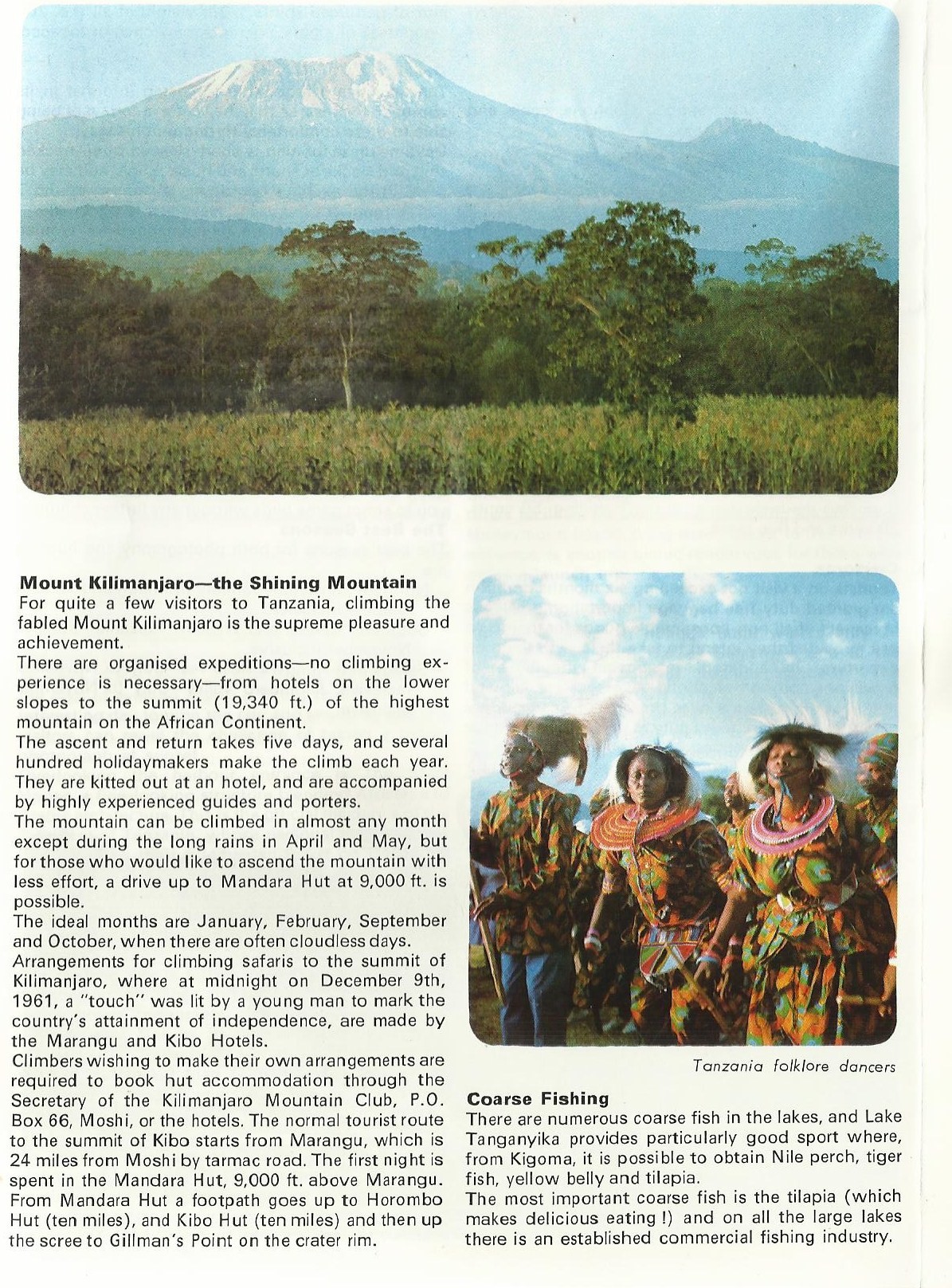
Mount Kilimanjaro the Shining Mountain
For quite a few visitors to Tanzania, climbing the fabled Mount Kilimanjaro is the supreme pleasure and achievement. There are organised expeditions—no climbing ex-perience is necessary—from hotels on the lower slopes to the summit (19,340 ft.) of the highest mountain on the African Continent. The ascent and return takes five days, and several hundred holidaymakers make the climb each year. They are kitted out at an hotel, and are accompanied by highly experienced guides and porters. The mountain can be climbed in almost any month except during the long rains in April and May, but for those who would like to ascend the mountain with less effort, a drive up to Mandara Hut at 9,000 ft. is possible. The ideal months are January, February, September and October, when there are often cloudless days. Arrangements for climbing safaris to the summit of Kilimanjaro, where at midnight on December 9th, 1961, a "touch" was lit by a young man to mark the country's attainment of independence, are made by the Marangu and Kibo Hotels. Climbers wishing to make their own arrangements are required to book but accommodation through the Secretary of the Kilimanjaro Mountain Club, P.O. Box 66, Moshi, or the hotels. The normal tourist route to the summit of Kibo starts from Marangu, which is 24 miles from Moshi by tarmac road. The first night is spent in the Mandara Hut, 9,000 ft. above Marangu. From Mandara Hut a footpath goes up to Horombo Hut (ten miles), and Kibo Hut (ten miles) and then up the scree to Gillman's Point on the crater rim.
Coarse Fishing
There are numerous coarse fish in the lakes, and Lake Tanganyika provides particularly good sport where, from Kigoma, it is possible to obtain Nile perch, tiger fish, yellow belly and tilapia. The most important coarse fish is the tilapia (which makes delicious eating!) and on all the large lakes there is an established commercial fishing industry.
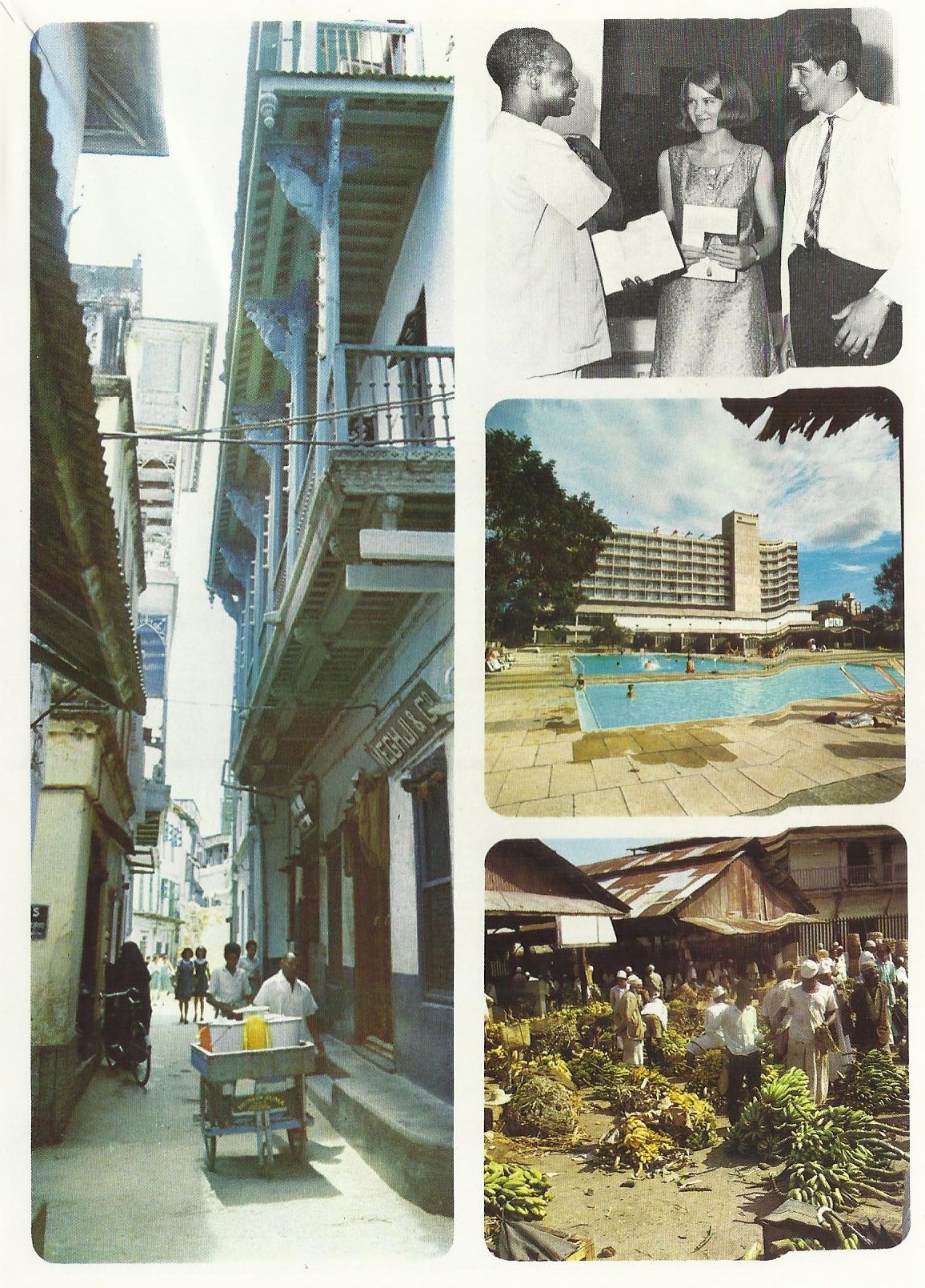

DISCOVER
Serengeti National Park
One million animals have their home in the Serengeti National Park. They live in total freedom on limitless plains scattered with rocky outcrops, patches of acacia bush, forest and occasional small rivers. Words can never adequately describe this animal stronghold of 5,000 square miles, the finest in Africa. Renowned for its 2,000 lion including the black-maned specimen, and more than 35 species of plains animals, the Serengeti also possesses an extensive selection of birdlife. There are an estimated 350,000 wildebeest and 180,000 zebra, and these star in the most spectacular of natural phenomenon, known as the Serengeti migration. Probably the best time to see them is from December through May when they are massed like an army on the shortgrass plains in the south of the Park. At this time they share the grazing with over half a million gazelle, together with attendant lion, cheetah, hunting dog and hyena, while vultures soar over-head. Then, in late May or early June, depending on the weather, the wildebeest, accompanied by the zebra, move away to the north and west where there is permanent water. Here they spend the next five months until, with the coming of the short rains in November, they gradually form up into a number of columns and head back to the shortgrass plains again. In the normal year, the best time to see a concentra-tion of wildebeest and other plains animals is during January and February when conditions are drier and a saloon car can be used for one's travels. However, from December through May there are excellent opportunities of seeing the animals con-centrated in the south, when they are still a fine sight and provide a great opportunity for seeing predators at work. Accommodation for visifors is at present provided in rondavels and tents at Seronera Camp, and a hotel is currently being built at Lobo, 40 miles north-east of Seronera. There are camping sites within two miles of Seronera Lodge, where a shop stocks a variety of tinned and packaged goods.

TANZANIA
LakeManyara National Park
Nature provides yet another setting for wildlife living in the area of the Lake Manyara National Park. Here, the wall of the Great Rift Valley forms the back-drop, before which lies the ground water forest teeming with animals, areas of open grassland, the lake foreshore, swamp and beyond, the loveliest of soda lakes. Few resorts in the world enjoy a setting comparable with that of the Lake Manyara Hotel, 1,000 ft. up on the escarpment wall. Its rooms afford breathtaking views of Africa's beauty. Those wishing to obtain worthwhile cine-film and photographs will rarely be disappointed First and foremost there are the lion. These display the unusual habit of spending many hpurs during the heat of the day blissfully resting or asleep on the limbs of large acacia trees, 10 ft. 20 ft. above the ground. Then there are the heards of buffalo, some of them 400 or more strong, while troupes of baboons are often seen moving en masse along the woodland glades. Among other species to be seen at Manyara are elephant, rhinoceros, impala, giraffe, leopard, zebra, bushbuck, reedbuck, waterbuck, blue monkey and vervet monkey. Lake Manyara National Park is only 123 square miles in area despite its variety of terrain and animal popula-tion. About 88 square miles of this total is lake. Manyara is also noted for its birdlife and more than 350 species have been recorded. One of the most beautiful sights to be enjoyed occurs when the flamingos, who move about in large flocks from one East African soda lake to another, descend on Manyara and form a line of shimmering pink stretching miles along the still waters.
Ngorongoro Crater
Rising high above the plains of the Serengeti is the wooded rim of the Ngorongoro Crater, location of another unique animal world. This time their refuge is the 100-square mile floor of a caldera or "collapsed" volcano, 2,000 ft. deep. The visitor's day begins early after breakfast with a drive down to this grassy stage where it is possible to move freely in search of the animals. The crater is the home of some 5,000 zebra, 15,000 wildebeest and 3,000 gazelles. Visitors will also usual-ly see most of the "Big Five"—elephant, rhino, lion, leopard and buffalo. No one may live or build on the crater floor, but visitors have a choice of accommodation on the rim. Here there are three lodges, and a fourth will open this year. Camping is permitted anywhere in the Conservation Area, and a camp site is maintained near the Con-servation Headquarters. Lake Ndutu Tented Camp is located in the Serengeti Plains on the route of the fabulous wildebeest migration.

THE MAGIC OF TANZANIA
Tanzania, formerly Tanganyika and Zanzibar, distils the magic and excitement that characterises Africa. It is a big country, with wildlife on an incomparable scale. Uncrowded beaches and palm-covered islands are washed by a blue ocean. Historic places recall the days of the 19th-century explorers. Record-breaking catches by those who go deep-sea fishing are often the rule rather than the exception. The enthusiast may embark on big game hunting safaris in the reserves. Prehistoric sites, rock paintings, ancient towns, mosques and palaces, together with the folklore and artistry of some 120 tribes now welded into one united nation offer the richest of African tapestries for the welcome vistors from other parts of the world. In the towns there are modern hotels offering the traveller comfort and service, with international cuisine and national dishes, and easily accessible to places of entertainment, well-stocked shops, restau-rants, markets and the bazaar. Leaving the towns behind, the visitor is accom-modated in comfortable Lodges set in undisturbed wildlife areas away from crowds and noise. One is free to travel at will, usually by field car, looking for the lion, elephant, leopard, buffalo and rhinoceros in their natural habitat. Observing and photographing the "Big Five", as these animals are called, and the many more species that abound in Tanzania, together with a thousand varieties of birds, is a certain delight for both novice and expert. In settings of incomparable beauty and grandeur the visitor tastes the magic of the African dawn and sunset, and hears the sounds of the bush that linger in the memory. From the limitless expanse of the Serengeti, where the last of the world's mammoth herds of plains game roam in their hundreds of thousands, to the green foothills of snow-mantled Mount Kilimanjaro, the beautiful island of Zanzibar and the silver beaches lapped by a warm ocean, Tanzania affords the visitor a true and vivid experience of Africa.
Motoring
Traffic drives on the left side of the road. An interna-tional driving licence or an overseas driving licence may be used by the vistior for the duration of his stay. Most models of European cars are sold and serviced in Tanzania, where there are many first-class garages. Petrol and service stations are situated on main highways and in all centres.
The Weather
A land without winter. This is Tanzania, where low temperatures just don't exist. Becaused of the large variations in altitude, the climate displays a great range from the languorous tropical warmth of the coast to the cool invigorating highlands. The first or long rains occur from April to May, while the short rains come between November and Decem-ber. On the coast (mean daily temperature 73-82 degrees Fahrenheit) the best time of the year is from June to September: although for the leisurely holidaymaker even the hot season is not too exhausting. However, intermittent rains are experienced from December to May. The four seasons are broadly the warmer dry season from January to March ; the first or long rains from April to May; the cooler dry season from June to September; and the short rains from November to December.
Language
The national language is Swahili, but English is widely spoken throughout the country.
Electricity
230 volts alternating current, standard fittings. All towns and a few rural centres have main electrical services.
Newspapers and radio
Apart from newspapers published in Swahili, there are two English-language dailies and one Sunday newspaper. Airmail editions of world newspapers are also obtainable, giving full world-news coverage.
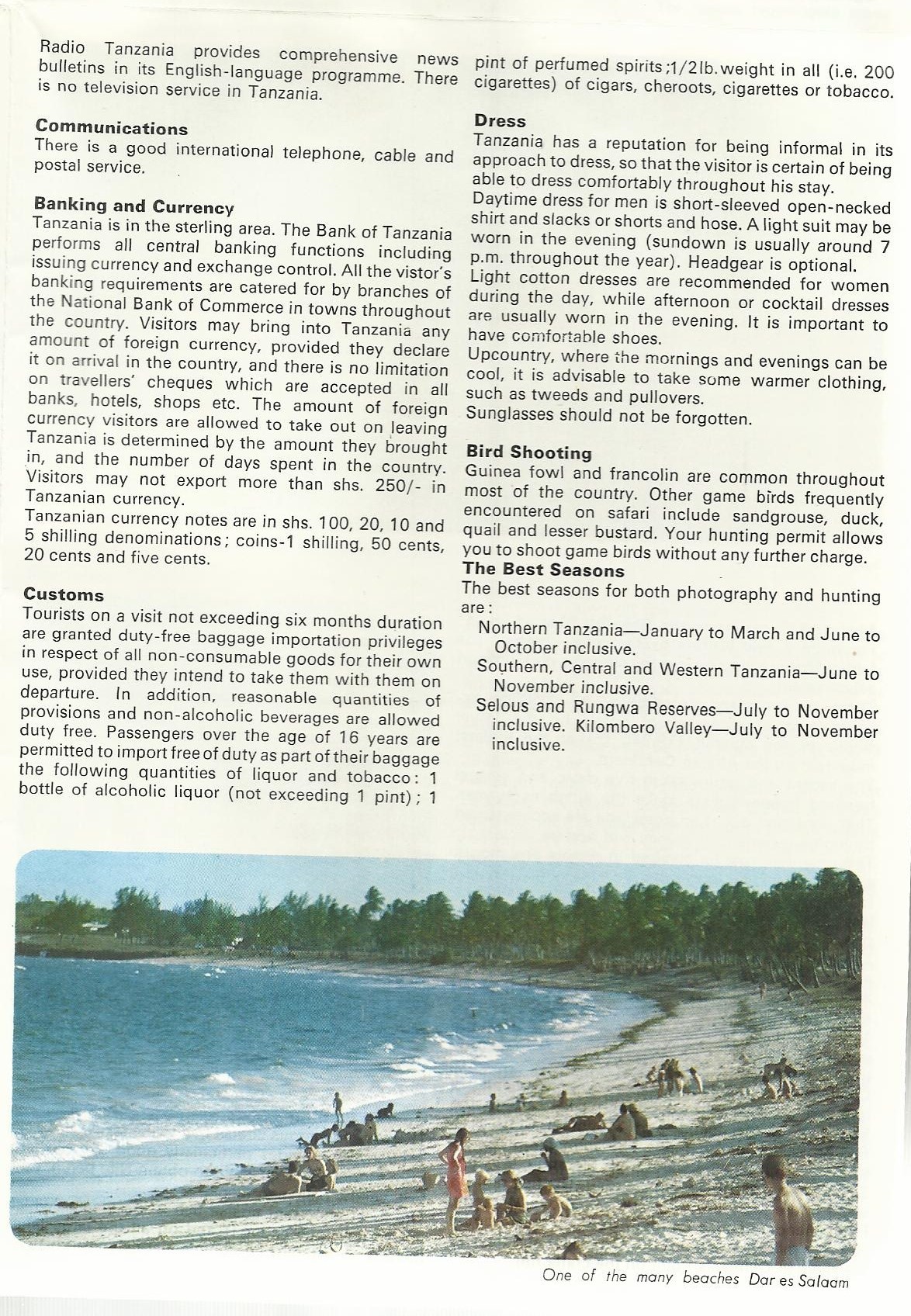
Radio Tanzania provides comprehensive news bulletins in its English-language programme. There cigarettes) of cigars, cheroots, cigarettes or tobacco. is no television service in Tanzania.
Communications
There is a good international telephone, cable and postal service.
Banking and Currency
Tanzania is in the sterling area. The Bank of Tanzania performs all central banking functions including issuing currency and exchange control. All the vistor's banking requirements are catered for by branches of the National Bank of Commerce in towns throughout the country. Visitors may bring into Tanzania any amount of foreign currency, provided they declare it on arrival in the country, and there is no limitation on travellers' cheques which are accepted in all banks, hotels, shops etc. The amount of foreign currency visitors are allowed to take out on leaving Tanzania is determined by the amount they brought in, and the number of days spent in the country. Visitors may not export more than shs. 250/- in Tanzanian currency. Tanzanian currency notes are in shs. 100, 20, 10 and 5 shilling denominations; coins-1 shilling, 50 cents, 20 cents and five cents.
Customs
Tourists on a visit not exceeding six months duration are granted duty-free baggage importation privileges in respect of all non-consumable goods for their own use, provided they intend to take them with them on departure. In addition, reasonable quantities of provisions and non-alcoholic beverages are allowed duty free. Passengers over the age of 16 years are permitted to import free of duty as part of their baggage the following quantities of liquor and tobacco : 1 bottle of alcoholic liquor (not exceeding 1 pint) ; 1 pint of perfumed spirits;1/21b.weight in all (i.e. 200 cigarettes) of cigars, cheroots, cigarettes or tobacco.
Dress
Tanzania has a reputation for being informal in its approach to dress, so that the visitor is certain of being able to dress comfortably throughout his stay. Daytime dress for men is short-sleeved open-necked shirt and slacks or shorts and hose. A light suit may be worn in the evening (sundown is usually around 7 p.m. throughout the year). Headgear is optional. Light cotton dresses are recommended for women during the day, while afternoon or cocktail dresses are usually worn in the evening. It is important to have comfortable shoes. Upcountry, where the mornings and evenings can be cool, it is advisable to take some warmer clothing, such as tweeds and pullovers. Sunglasses should not be forgotten.
Bird Shooting
Guinea fowl and francolin are common throughout most of the country. Other game birds frequently encountered on safari include sandgrouse, duck, quail and lesser bustard. Your hunting permit allows you to shoot game birds without any further charge.
The Best Seasons
The best seasons for both photography and hunting are :
- Northern Tanzania January to March and June to October inclusive.
- Southern, Central and Western Tanzania—June to November inclusive.
- Selous and Rungwa Reserves-July to November inclusive. Kilombero Valley July to November inclusive.
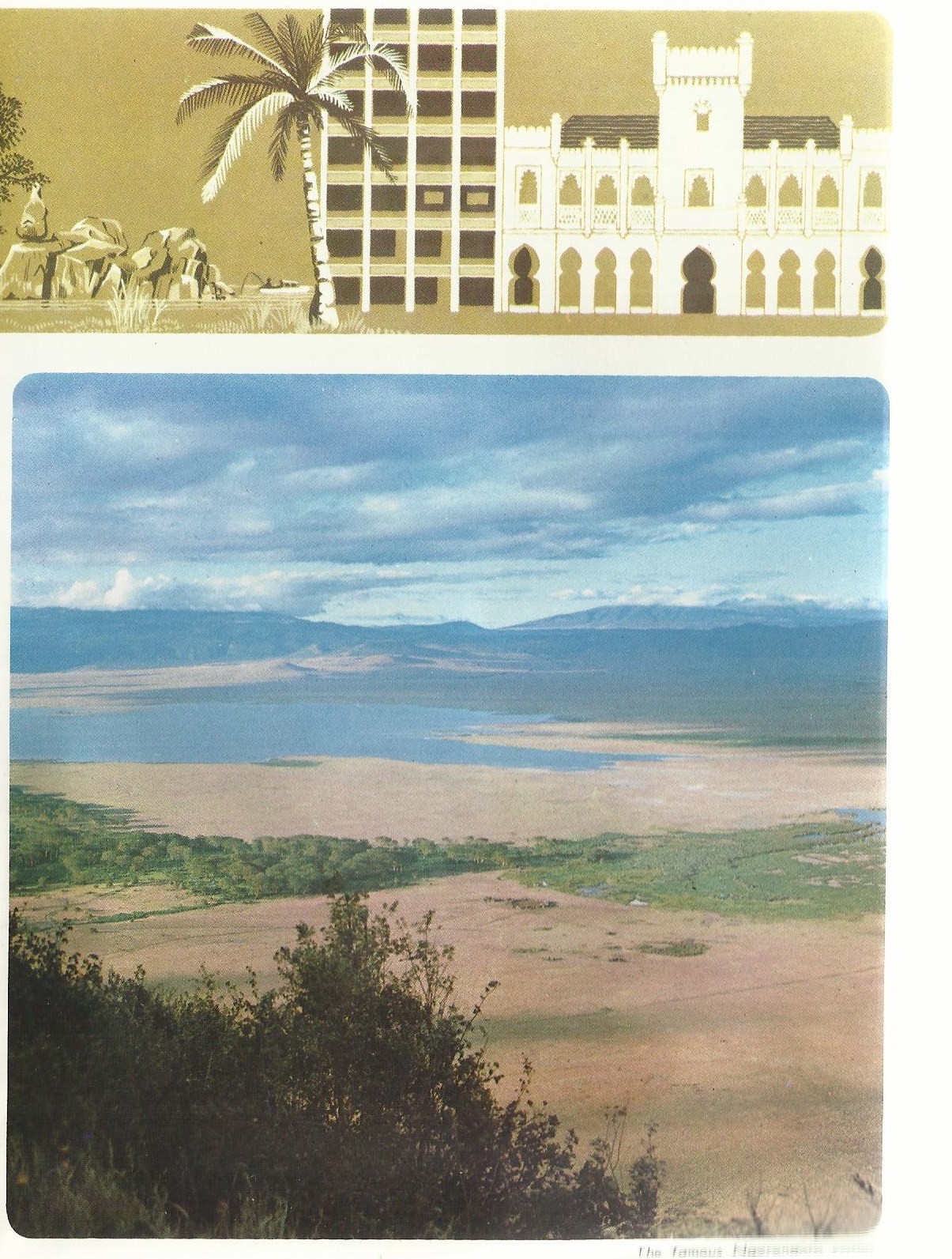
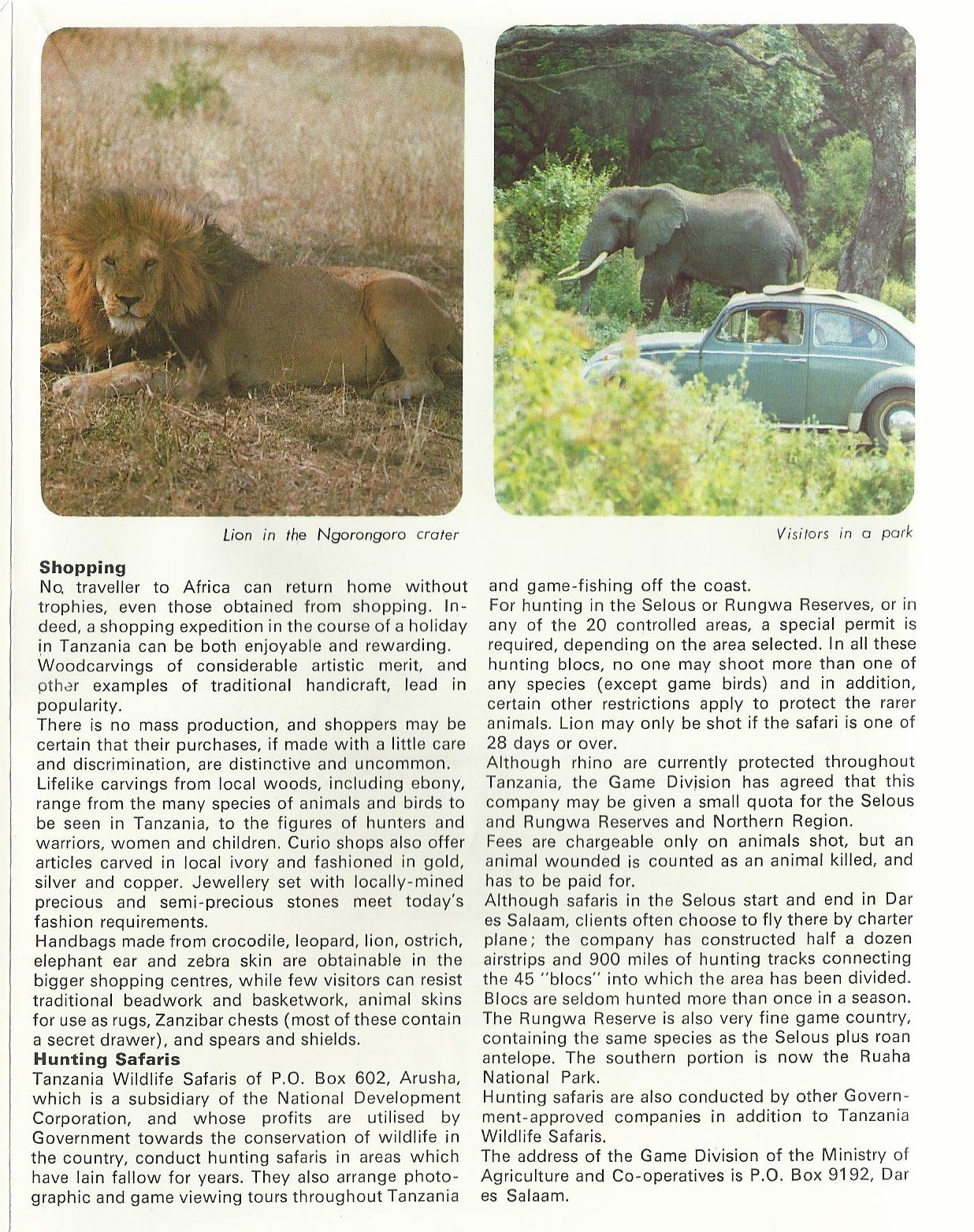
Radio Tanzania provides comprehensive news bulletins in its English-language programme. There cigarettes) of cigars, cheroots, cigarettes or tobacco. is no television service in Tanzania.
Communications
There is a good international telephone, cable and postal service.
Banking and Currency
Tanzania is in the sterling area. The Bank of Tanzania performs all central banking functions including issuing currency and exchange control. All the vistor's banking requirements are catered for by branches of the National Bank of Commerce in towns throughout the country. Visitors may bring into Tanzania any amount of foreign currency, provided they declare it on arrival in the country, and there is no limitation on travellers' cheques which are accepted in all banks, hotels, shops etc. The amount of foreign currency visitors are allowed to take out on leaving Tanzania is determined by the amount they brought in, and the number of days spent in the country. Visitors may not export more than shs. 250/- in Tanzanian currency. Tanzanian currency notes are in shs. 100, 20, 10 and 5 shilling denominations; coins-1 shilling, 50 cents, 20 cents and five cents.
Customs
Tourists on a visit not exceeding six months duration are granted duty-free baggage importation privileges in respect of all non-consumable goods for their own use, provided they intend to take them with them on departure. In addition, reasonable quantities of provisions and non-alcoholic beverages are allowed duty free. Passengers over the age of 16 years are permitted to import free of duty as part of their baggage the following quantities of liquor and tobacco : 1 bottle of alcoholic liquor (not exceeding 1 pint) ; 1 pint of perfumed spirits;1/21b.weight in all (i.e. 200 cigarettes) of cigars, cheroots, cigarettes or tobacco.
Dress
Tanzania has a reputation for being informal in its approach to dress, so that the visitor is certain of being able to dress comfortably throughout his stay. Daytime dress for men is short-sleeved open-necked shirt and slacks or shorts and hose. A light suit may be worn in the evening (sundown is usually around 7 p.m. throughout the year). Headgear is optional. Light cotton dresses are recommended for women during the day, while afternoon or cocktail dresses are usually worn in the evening. It is important to have comfortable shoes. Upcountry, where the mornings and evenings can be cool, it is advisable to take some warmer clothing, such as tweeds and pullovers. Sunglasses should not be forgotten.
Bird Shooting
Guinea fowl and francolin are common throughout most of the country. Other game birds frequently encountered on safari include sandgrouse, duck, quail and lesser bustard. Your hunting permit allows you to shoot game birds without any further charge.
The Best Seasons
The best seasons for both photography and hunting are :
- Northern Tanzania January to March and June to October inclusive.
- Southern, Central and Western Tanzania—June to November inclusive.
- Selous and Rungwa Reserves-July to November inclusive. Kilombero Valley July to November inclusive.

TANZANIA
How to get there
Tanzania is served by many trunk airlines. You can touch down at Dar es Salaam's modern International Airport only eleven hours after leaving London, 18 hours after climbing aboard your aircraft in New York, or 12 hours after taking off from Frankfurt. You can fly in comfort and at jet speed, conserving all your time off for the holiday. Fares are surprisingly economic from all world centres. The value to be derived from a holiday in Tanzania is not to be measured only in terms of health and well-being, but also in the knowledge of having made an adventurous and educational journey to a location of infinite interest. Depending on your choice of features within Tanzania, you will continue your travels on arrival in the country by private car, minibus, four-wheel-drive field car, charter plane or one of the up-to-date aircraft used on the extensive domestic air network
Time
East African Standard Time, which is three hours ahead of Greenwich Mean Time, is used in Tanzania.
Internal air transport
A comprehensive internal air service covering all main centres in Tanzania, including the mainland and Zanzibar, is provided by East African Airways.
Surface Transport
Fast and comfortable services operated by the East African Railways and Harbours traverse the country from East to West, from Dar es Salaam to Kigoma and
Mwanza and from Tanga to Moshi. A link line con-nects the Central and Tanga lines and provides a through service to the Northern Region, Nairobi and Mombasa. At Kigoma on Lake Tanganyika a fortnightly steamer service operates to Mpulungu on the Zambia Border and at Mwanza the Lake Victoria steamers provide a pleasant and leisurely weekly contact with Uganda and Kenya ports. The Railway administration also operates road services from Arusha to Dodoma and between most important centres in Southern Tanzania, and these connect with road services to Zambia.
Good health
Tanzania has a healthy climate. In accordance with usual practice, visitors must be in possession of international certificates of vaccination against smallpox and inoculation against yellow fever. Although mosquito control has greatly reduced the risk of malaria in built-up areas like Dar es Salaam, and is uncommon when the altitude exceeds 5,000 ft. above sea-level, it is advisable for visitors to begin taking a prophylactic two weeks before arriving in Tanzania. Tablets can be obtained from chemists without prescription. Although fewer people wear hats these days, light headgear is recommended, particularly for children and adults who are exposed to the sun for long periods. Good sunglasses are advisable on the white sandy beaches and when on safari. Chemists' shops are well stocked, and all holiday centres are served by hospitals and qualified doctors and dentists.
................................................................................................

Thai
International
Discover
Bali
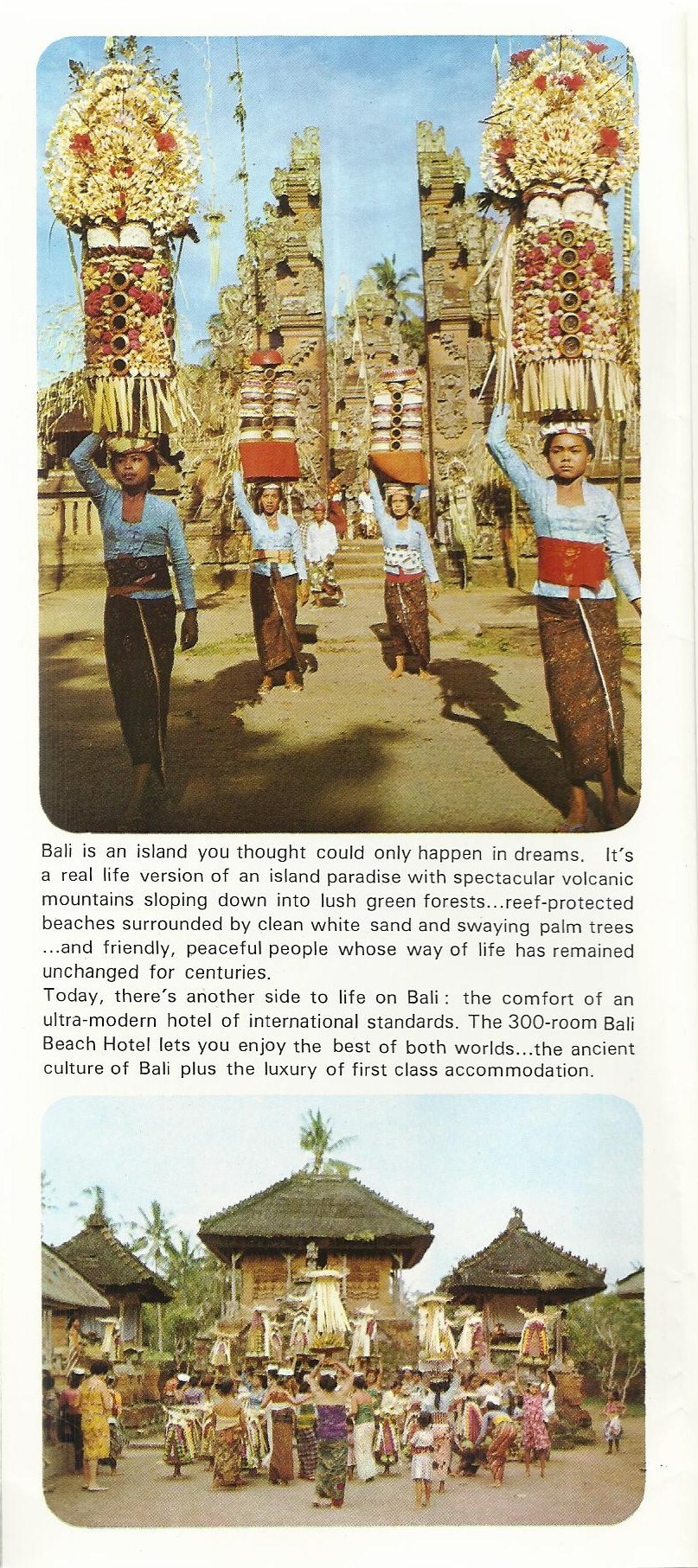
Bali is an island you thought could only happen in dreams. It's a real life version of an island paradise with spectacular volcanic mountains sloping down into lush green forests...reef-protected beaches surrounded by clean white sand and swaying palm trees ..and friendly, peaceful people whose way of life has remained unchanged for centuries. Today, there's another side to life on Bali : the comfort of an ultra-modern hotel of international standards. The 300-room Bali Beach Hotel lets you enjoy the best of both worlds...the ancient culture of Bali plus the luxury of first class accommodation.
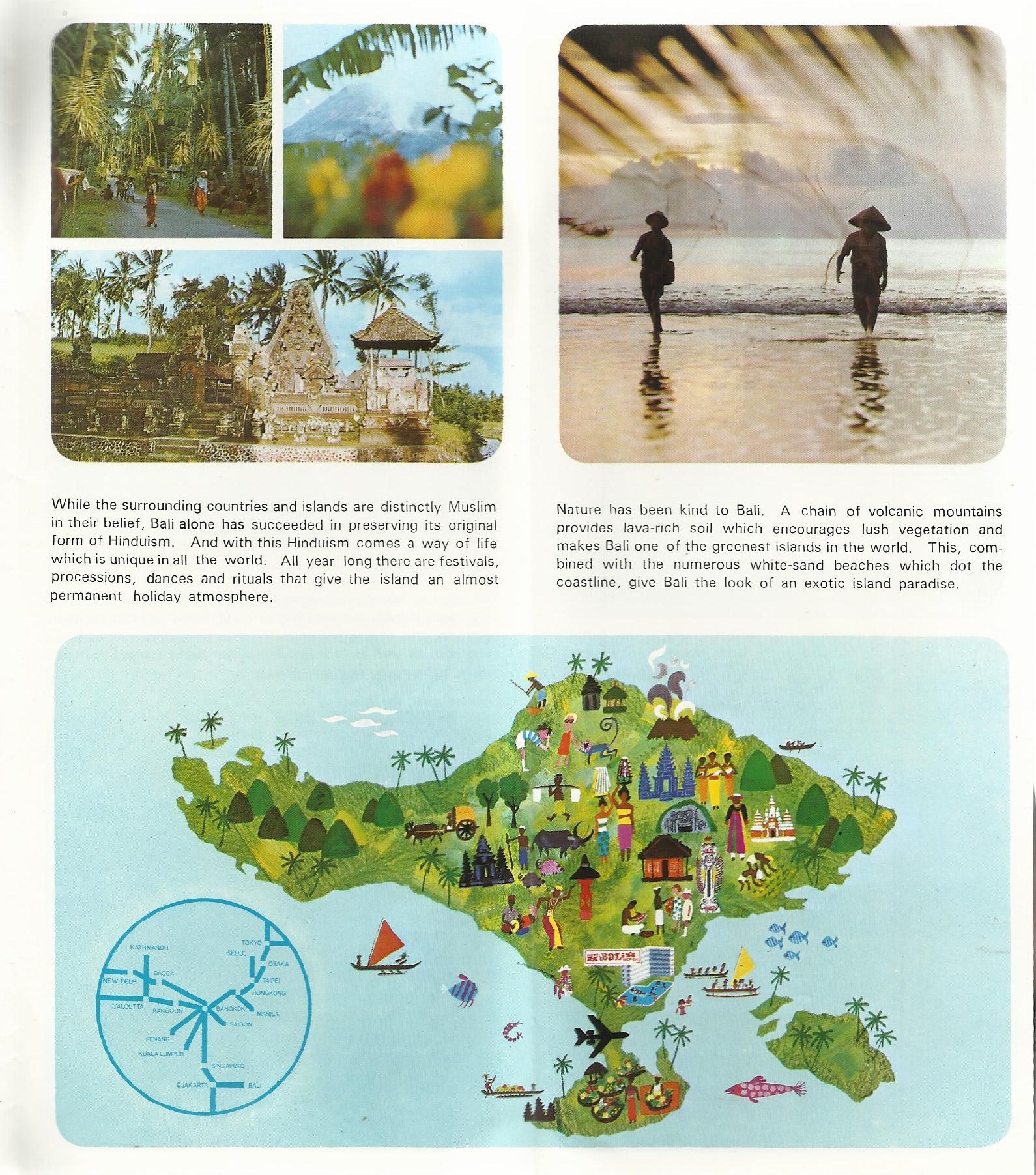
While the surrounding countries and islands are distinctly Muslim in their belief, Bali alone has succeeded in preserving its original form of Hinduism. And with this Hinduism comes a way of life which is unique in all the world. All year long there are festivals, processions, dances and rituals that give the island an almost permanent holiday atmosphere.
Nature has been kind to Bali. A chain of volcanic mountains provides lava-rich soil which encourages lush vegetation and makes Bali one of the greenest islands in the world. This, com-bined with the numerous white-sand beaches which dot the coastline, give Bali the look of an exotic island paradise.

The influence of Hinduism is reflected not only in the people and their way of life but also in the landscape and architecture of the island. In an area of just over 2,000 square miles, the Balinese have constructed more than 10,000 temples, each one intricately carved and many of them centuries old.
The twentieth century came to Bali with the opening of the luxurious, 300-room Bali Beach Hotel. The hotel is part of the world famous Inter-Continental group-each room is fully carpeted and air-conditioned and has its own bathroom and private balcony. There's an olympic size swim-ming pool as well as facilities for recreational activities such as tennis, badminton, skin-diving, etc. Located near the heart of Bali's main tourist attractions, the Bali Beach Hotel lets you enjoy the best of both worlds, the ancient culture of Bali plus the comfort of ultra-modern accom-modation.
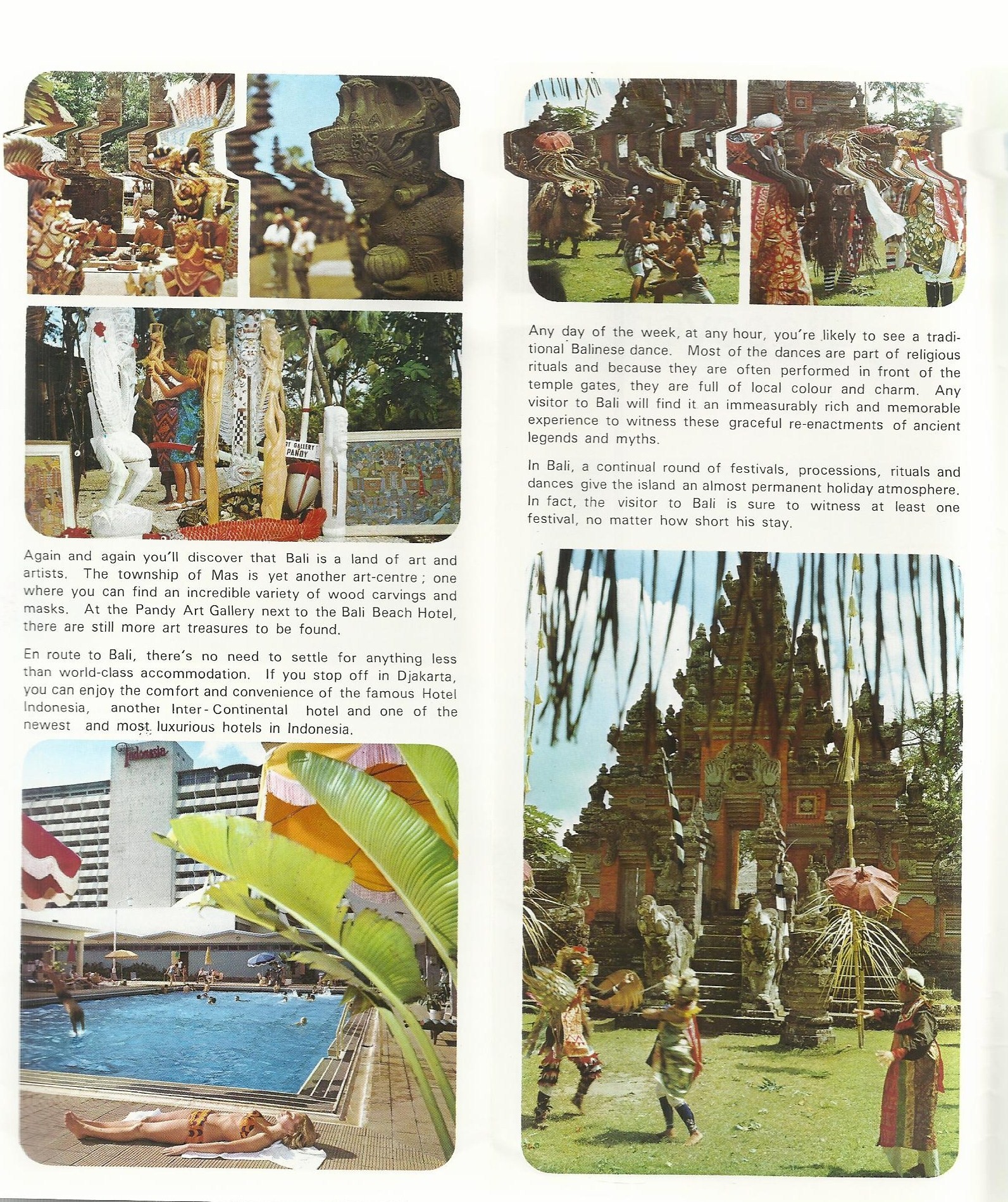
Again and again you'll discover that Bali is a land of art and artists. The township of Mas is yet another art-centre ; one where you can find an incredible variety of wood carvings and masks. At the Pandy Art Gallery next to the Bali Beach Hotel, there are still more art treasures to be found. En route to Bali, there's no need to settle for anything less than world-class accommodation. If you stop off in Djakarta, you can enjoy the comfort and convenience of the famous Hotel Indonesia, another Inter- Continental hotel and one of the newest and most luxurious hotels in Indonesia.
Any day of the week, at any hour, you're likely to see a tradi-tional Balinese dance. Most of the dances are part of religious rituals and because they are often performed in front of the temple gates, they are full of local colour and charm. Any visitor to Bali will find it an immeasurably rich and memorable experience to witness these graceful re-enactments of ancient legends and myths. In Bali, a continual round of festivals, processions, rituals and dances give the island an almost permanent holiday atmosphere. In fact, the visitor to Bali is sure to witness at least one festival, no matter how short his stay.
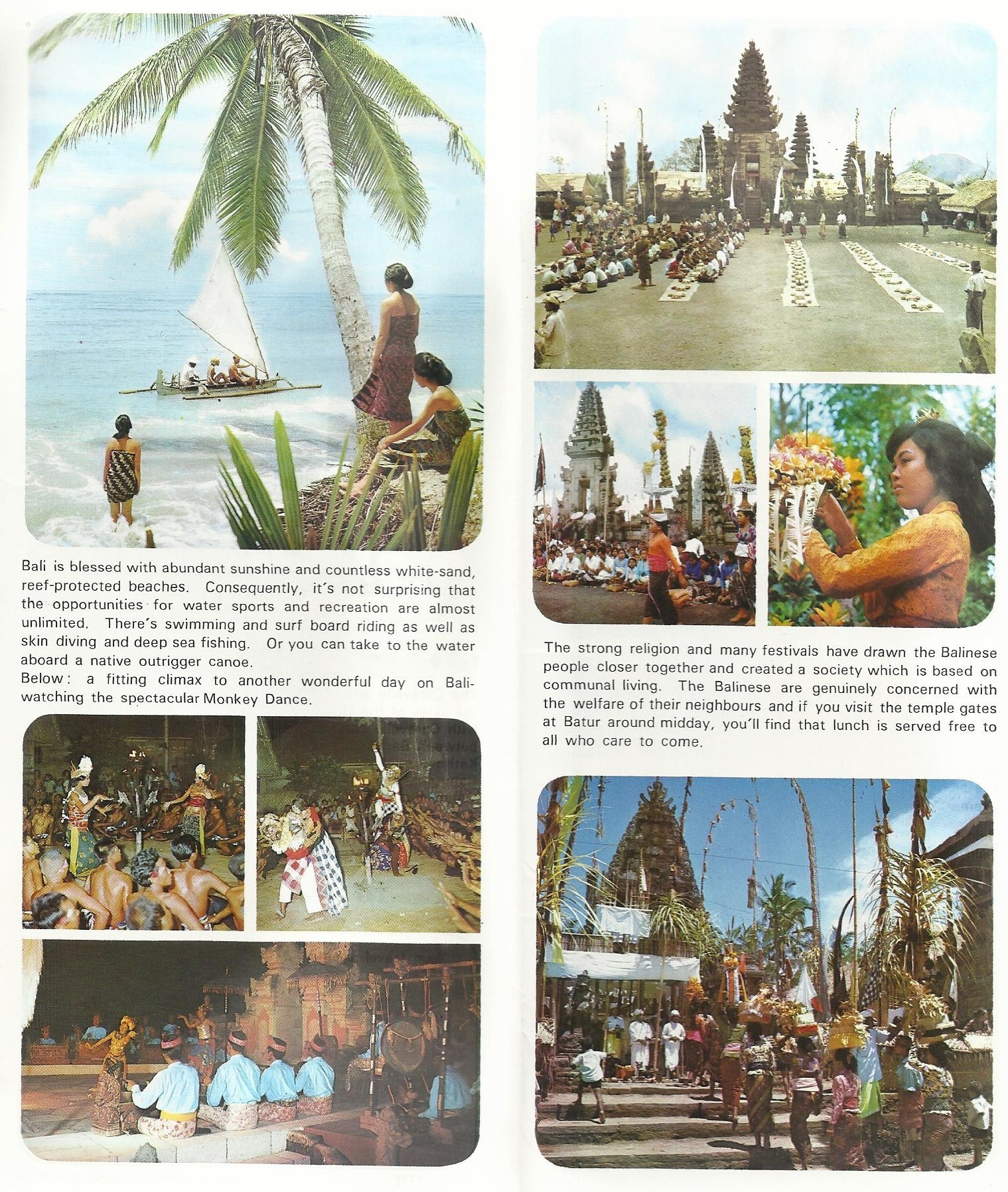
Bali is blessed with abundant sunshine and countless white-sand, reef-protected beaches. Consequently, it's not surprising that the opportunities for water sports and recreation are almost unlimited. There's swimming and surf board riding as well as skin diving and deep sea fishing. Or you can take to the water aboard a native outrigger canoe. Below : a fitting climax to another wonderful day on Bali-watching the spectacular Monkey Dance.
The strong religion and many festivals have drawn the Balinese people closer together and created a society which is based on communal living. The Balinese are genuinely concerned with the welfare of their neighbours and if you visit the temple gates at Batur around midday, you'll find that lunch is served free to all who care to come.
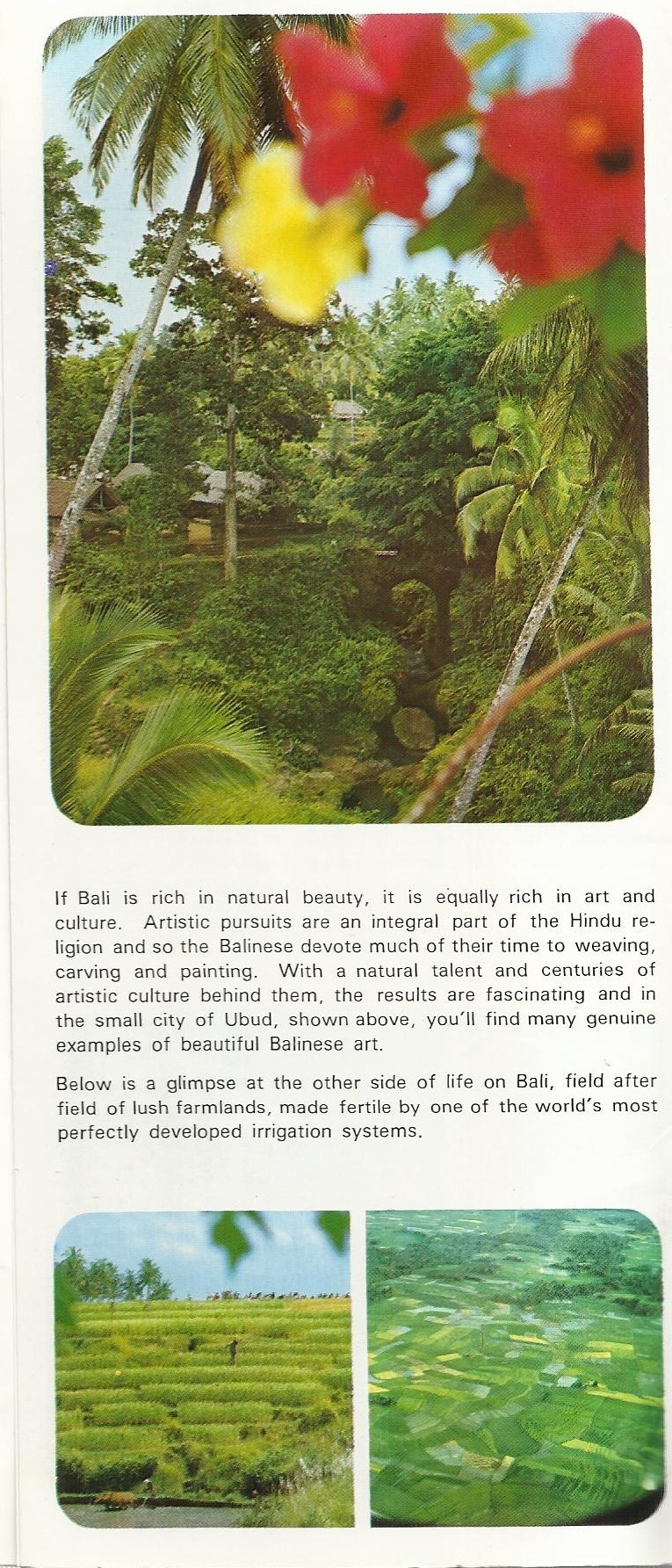
If Bali is rich in natural beauty, it is equally rich in art and culture. Artistic pursuits are an integral part of the Hindu re-ligion and so the Balinese devote much of their time to weaving, carving and painting. With a natural talent and centuries of artistic culture behind them, the results are fascinating and in the small city of Ubud, shown above, you'll find many genuine examples of beautiful Balinese art. Below is a glimpse at the other side of life on Bali, field after field of lush farmlands, made fertile by one of the world's most perfectly developed irrigation systems.
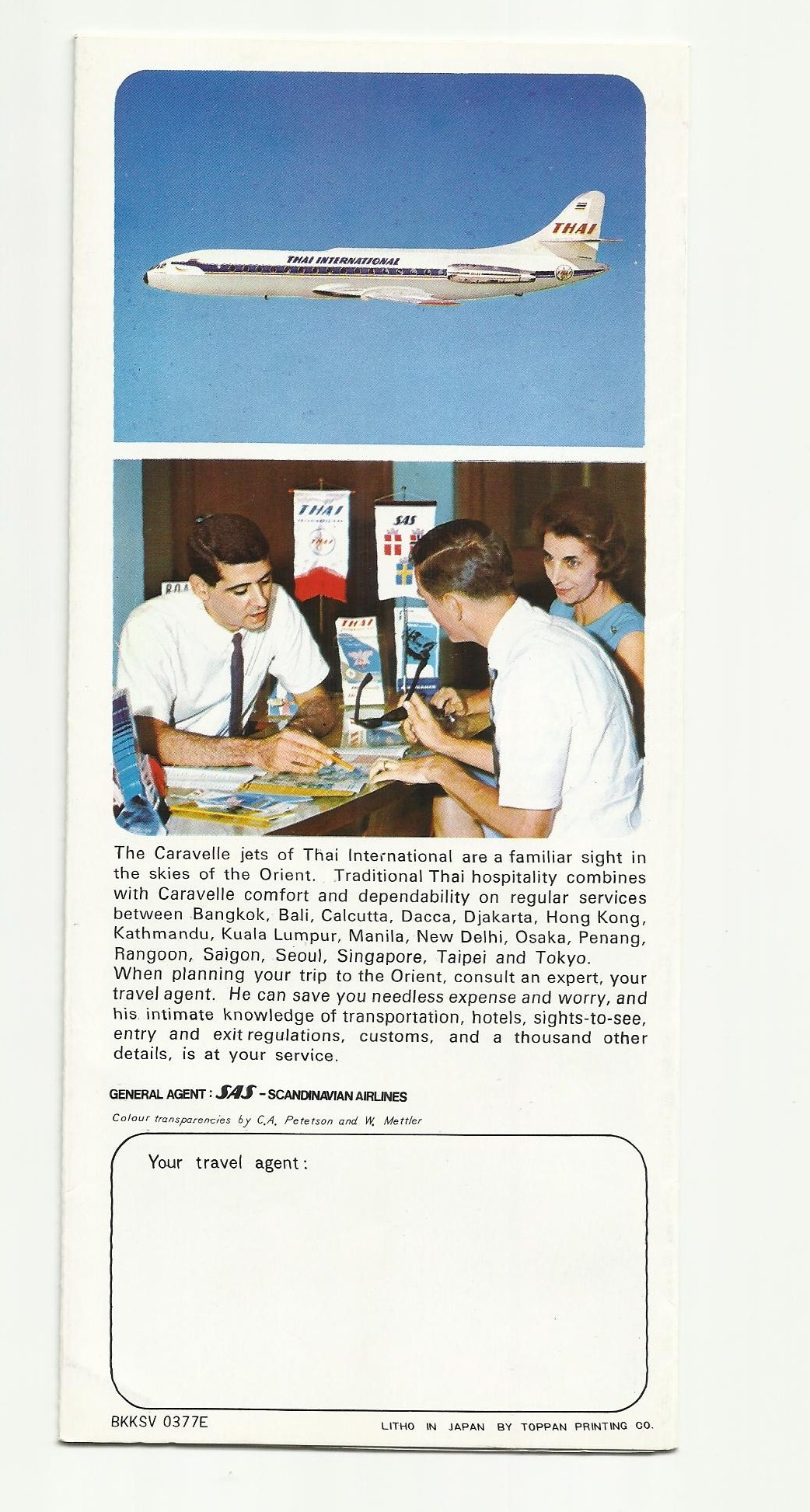
Ultimo aggiornamento: 16 aprile 2018
